Fall Color Report
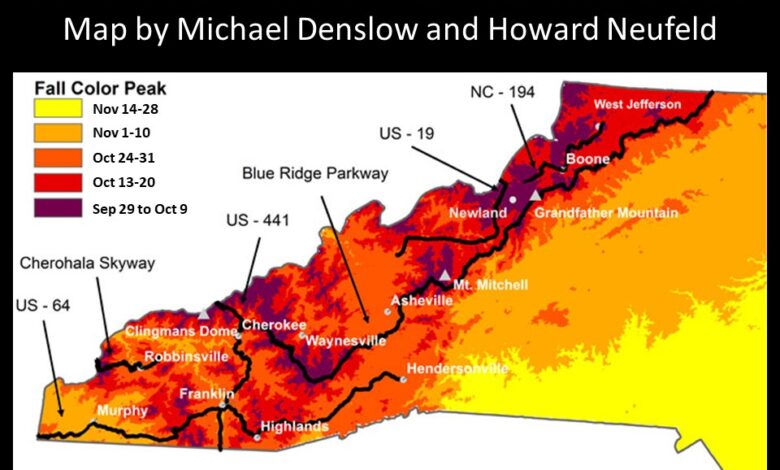
2023 Updates
For the 12th year in a row, WataugaOnline.com is teaming up with Dr. Howard Neufeld, Professor of Plant Eco-physiology at Appalachian State University, better known as The Fall Color Guy to provide information as the colors start changing. For reports from previous years click here.
Dr. Neufeld shared some thoughts just before previous fall seasons that are still relevant for this or any fall season:
As for wet weather, there have been some publications on the impacts of weather on fall color (especially timing, not so much quality). Precipitation has only minor effects on timing in the fall. Temperature is more important. So, at this point, I don't see anything to make me think that fall colors will be adversely affected, either in timing or quality.
What happens in mid- to late August and in September, temperature-wise, will be more important, especially for quality (notably the intensity of the red colors)”.
People think fall colors are good when they last a long time, and have plenty of brilliant reds interspersed with the oranges and yellows. So, the quality will depend on how much “redness” we have this fall.
Trees tend to make more red colors (anthocyanins) in the fall when it's cool and sunny, and if we have a slight but not severe drought.
Sunny days means more photosynthesis, and more sugars produced in the leaves, and sugars induce anthocyanin production.
A slight drought impairs uptake of nitrogen (we think) and some experiments suggest that plants low on N make more anthocyanins.
Usually, fall colors peak around Oct 11-14 in the Boone area; sooner by a few days up to a week at higher elevations, later at lower ones. Nice colors can stick around for a week or more, although the peak usually comes and goes in just a few days, weather permitting (no high winds for example)”.
Grandfather Mountain Daily Fall Color Report | Oct. 31, 2023:
Happy Halloween! Today marks the end of our daily reports. Locals and visitors alike enjoyed an extended fall color season this year, with great autumn hues throughout the month of October in the N.C. High Country. Forecasts show an abrupt drop in temperature today into tomorrow.
This photo was taken from Chestoa View Overlook, located at Milepost 320.8 along the Blue Ridge Parkway.
Photo by Skip Sickler | Grandfather Mountain Stewardship Foundation
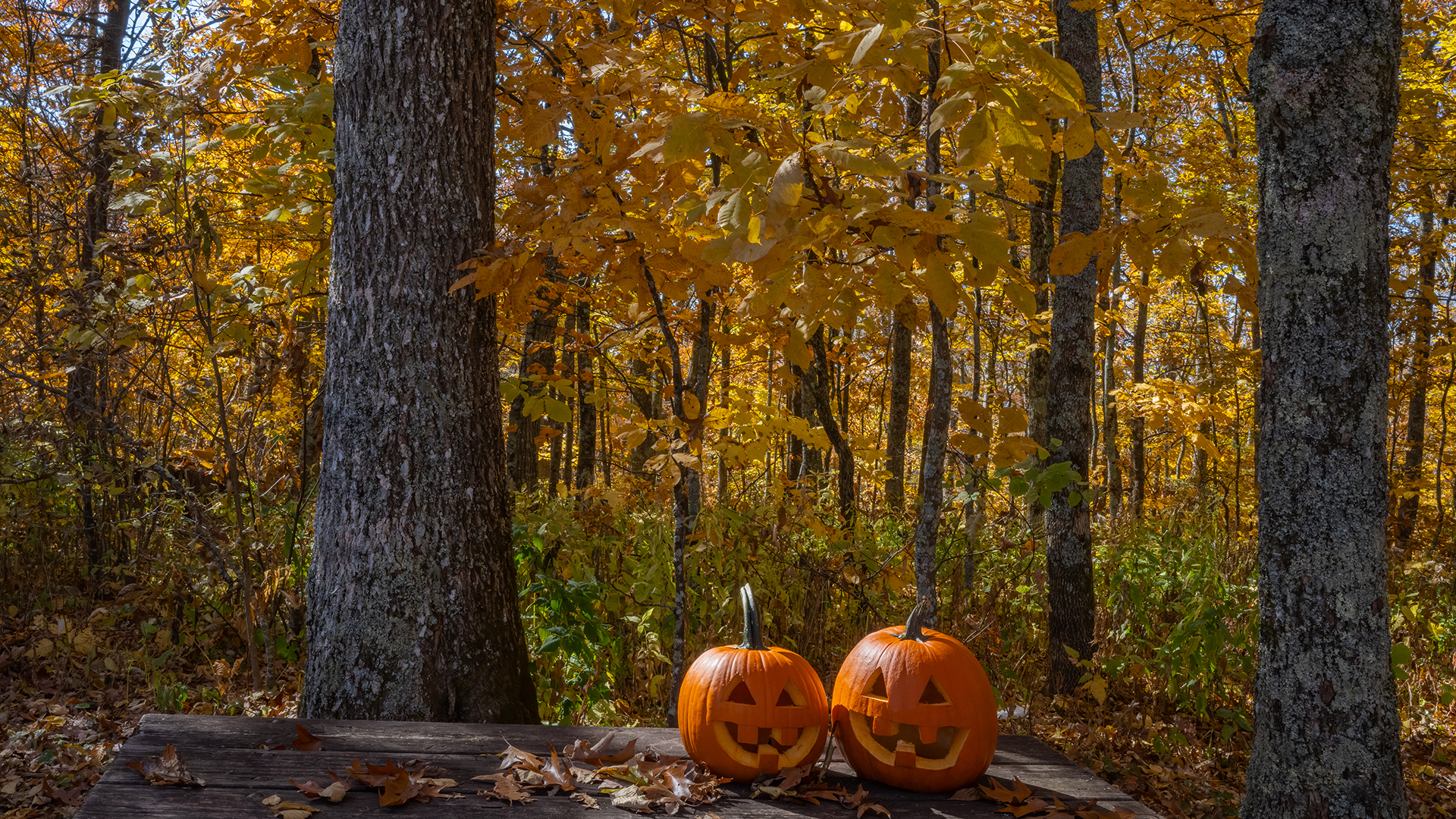
Grandfather Mountain Daily Fall Color Report | Oct. 30, 2023:
Though some nice pockets of fall color remain, Grandfather Mountain is now past peak as we near the end of October. The Mile High Swinging Bridge area and higher overlooks remain prime viewing locations for color descending to the Piedmont.
Today’s photo of the mountain’s lofty peaks was taken from U.S. 221, just south of MacRae Meadows.
Photo by Skip Sickler | Grandfather Mountain Stewardship Foundation

Grandfather Mountain Daily Fall Color Report | Oct. 29, 2023:
This sunset shot in Valle Crucis shows a late autumn view of golden and crimson hues. The drive along N.C. 194 between Banner Elk and Valle Crucis is always a noteworthy route for fall color viewing.
Photo by Skip Sickler | Grandfather Mountain Stewardship Foundation
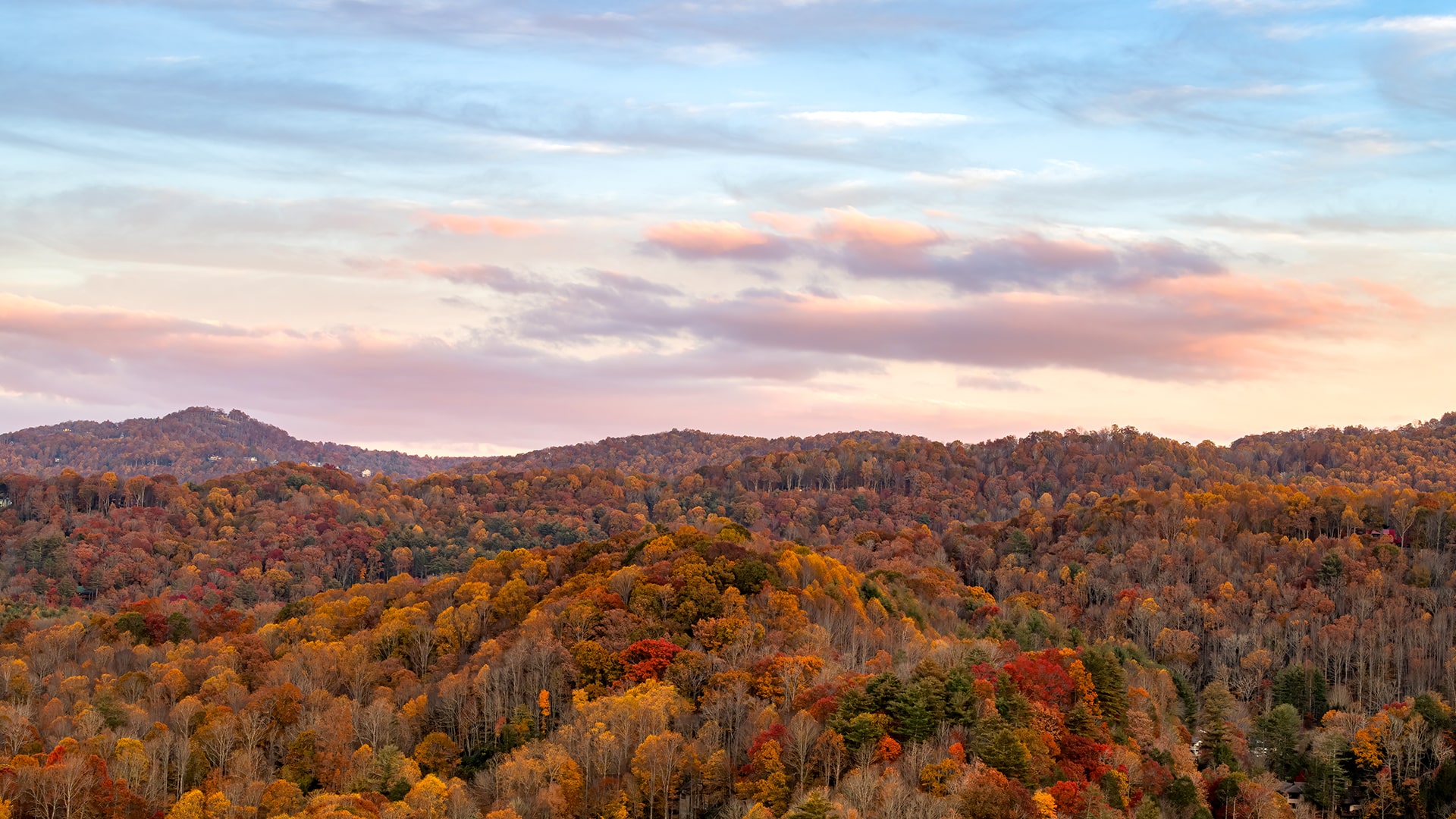
Grandfather Mountain Daily Fall Color Report | Oct. 28, 2023:
Fall colors continue to put on a show in the N.C. High Country, as shown in this photo taken near the Linville Falls Visitor Center. Sunshine and warmer temperatures make this weekend perfect for an autumn stroll or hike. This bridge leads to a network of trails that show spectacular views of Linville Falls.
The best autumn hues can be seen between 2,500 and 4,000 feet in elevation. The Blue Ridge Parkway between Linville and Little Switzerland would also be nice right now for leaf-peeping adventures.
Photo by Leslie Restivo | Grandfather Mountain Stewardship Foundation
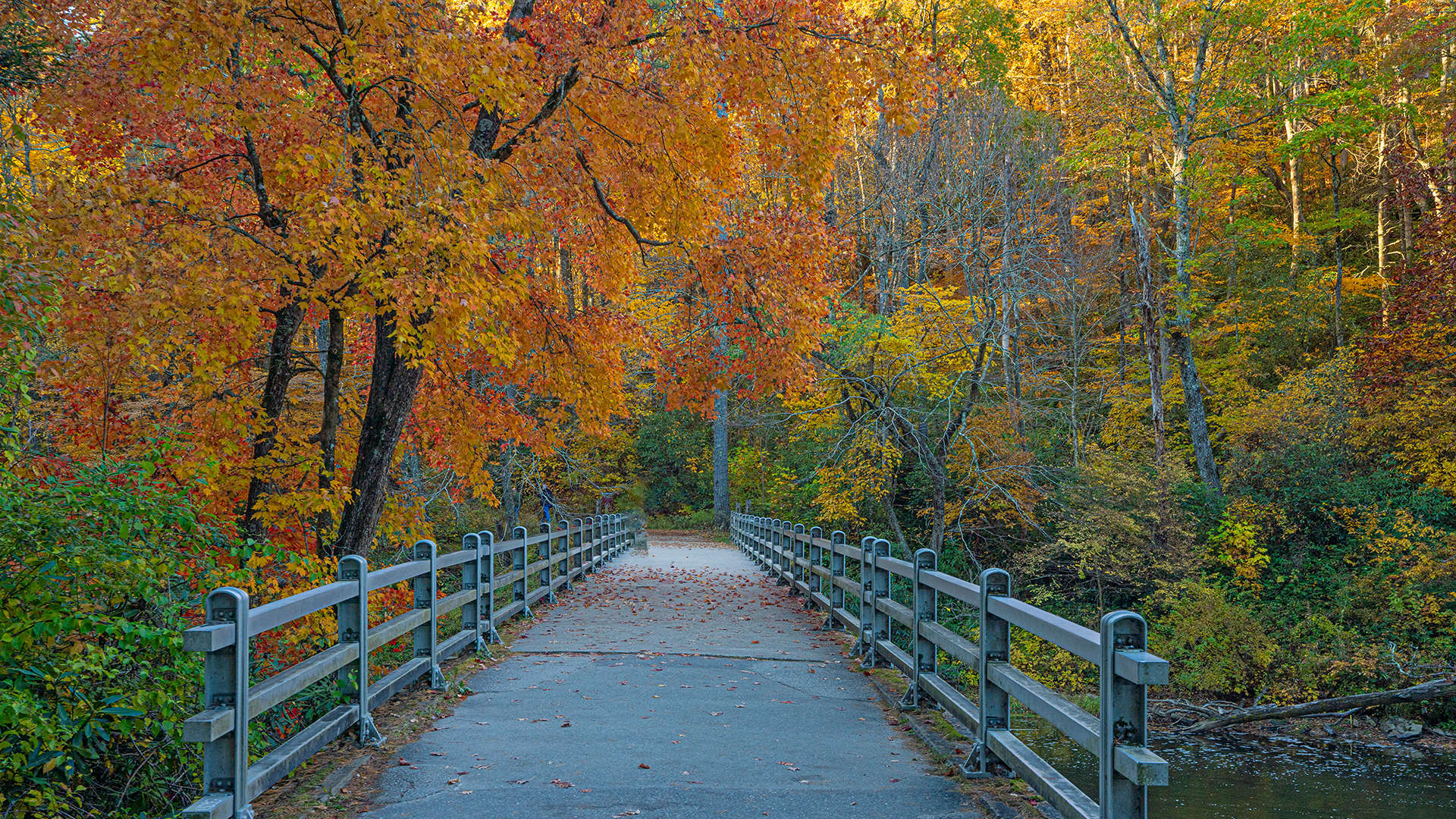
Grandfather Mountain Daily Fall Color Report | Oct. 27, 2023:
Autumn lights up the landscape in this image taken near Grandfather Mountain’s park road, just above MacRae Meadows. There have been some spectacular yellow hues to be seen this week. The 2-mile drive on U.S. 221 between Linville and Grandfather Mountain’s entrance gate has been ablaze with color, especially in the light of early evening.
Grandfather Mountain still has vibrant foliage in the lower half of the park, from the entrance up to the area around the Wilson Center and Mildred the Bear Environmental Habitats. The top half of the park serves as the perfect vantage point to see fall color as it descends into lower elevations.
Photo by Skip Sickler | Grandfather Mountain Stewardship Foundation
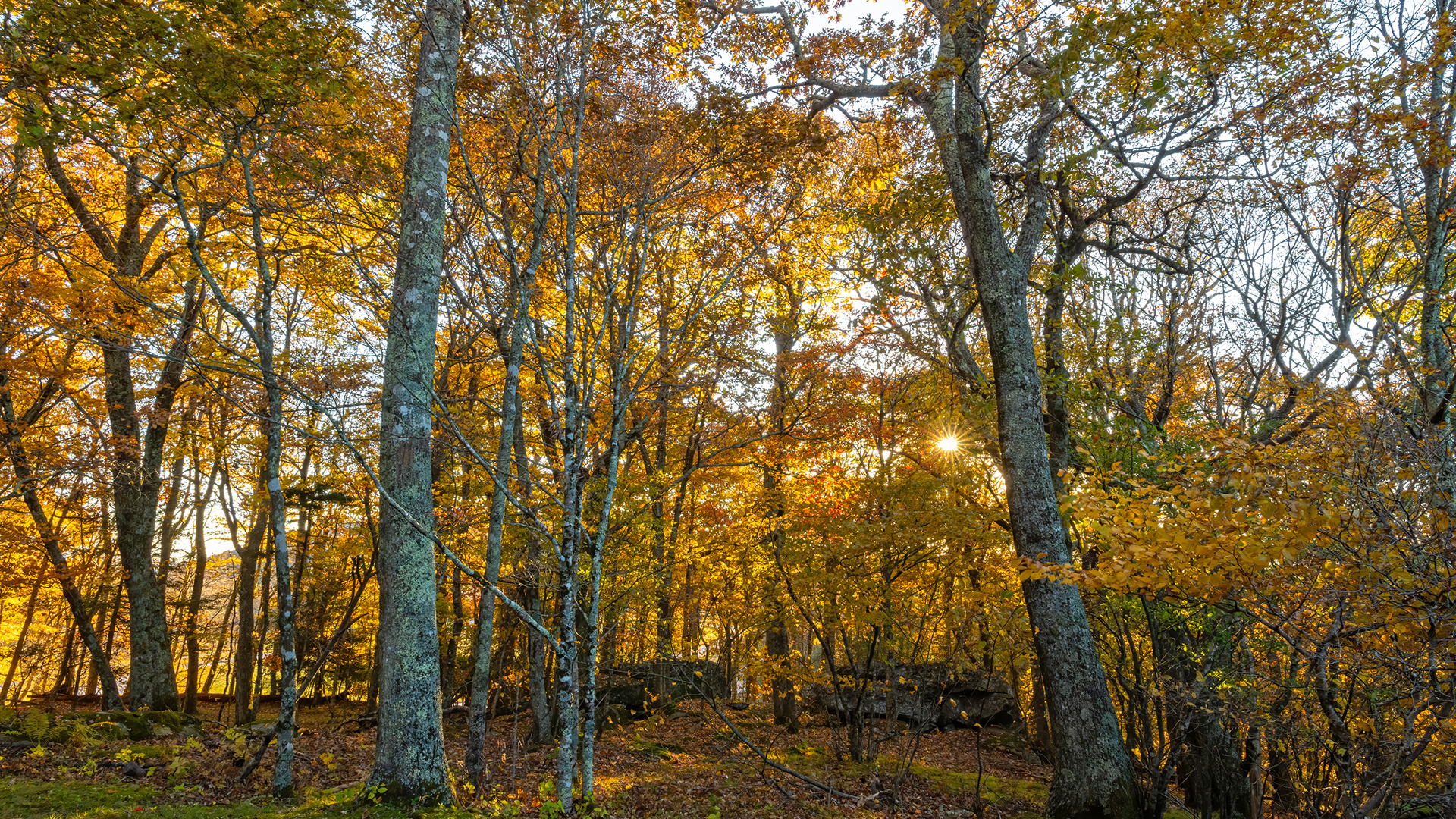
Grandfather Mountain Daily Fall Color Report | Oct. 26, 2023:
Golden hues of sunrise brighten fall foliage in the Linville Gorge, as seen in this image taken from The Chimneys near Table Rock. Currently, the best fall color can be seen between 3,000 and 4,000 feet in elevation.
Nice weather should continue into the weekend in the N.C. High Country and make for ideal leaf-looking conditions.
Photo by Leslie Restivo | Grandfather Mountain Stewardship Foundation
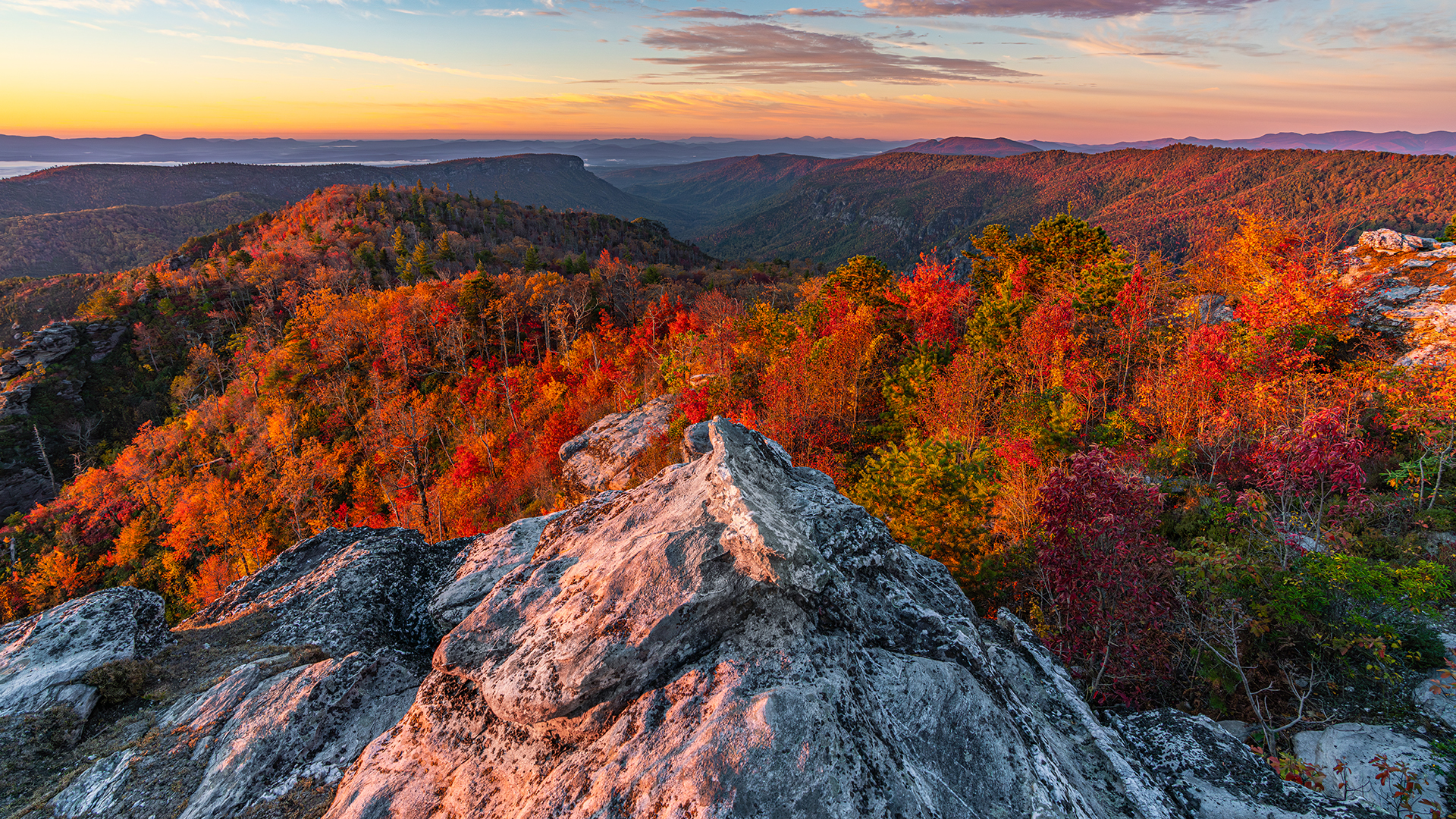
Grandfather Mountain Daily Fall Color Report | Oct. 25, 2023:
Fall color and sunlight illuminate this iconic bridge along the Blue Ridge Parkway in this photo taken near the Linville Falls Picnic Area, at Milepost 316.5. The great weather this week provides ideal conditions for a scenic autumn drive.
Heading south along the Blue Ridge Parkway from the Grandfather Mountain area still provides a nice look at fall foliage. Routes into the High Country from lower elevations, such as U.S. 321 between Lenoir and Blowing Rock, N.C. 181 between Morganton and Pineola and U.S. 221 between Marion and Linville, are also currently offering picturesque views.
Photo by Skip Sickler | Grandfather Mountain Stewardship Foundation
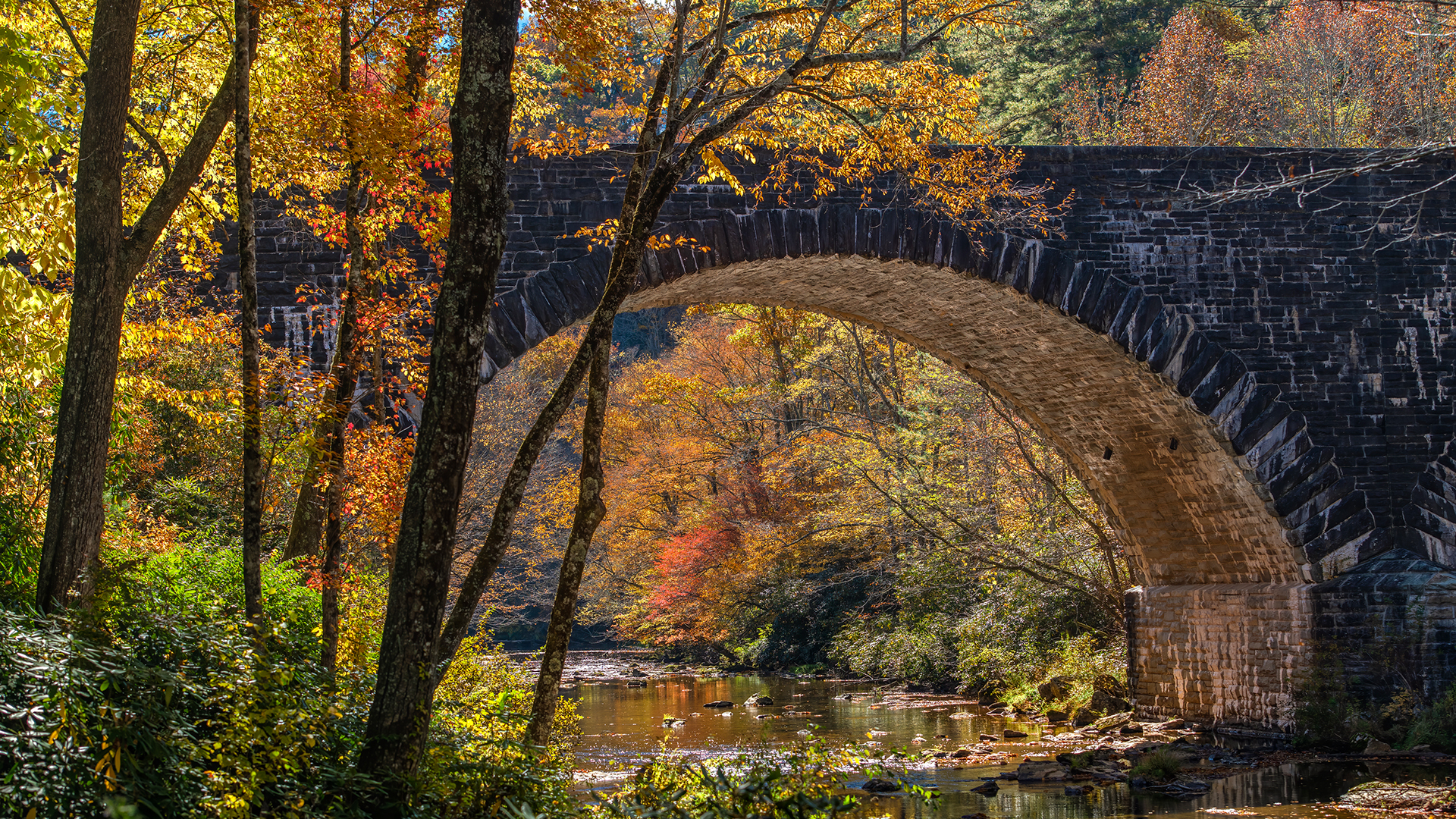
Grandfather Mountain Daily Fall Color Report | Oct. 24, 2023:
As we move into late October, Grandfather continues to be a great color destination. The lower half of the mountain currently has bright autumn hues on display, as seen in this photo taken from the Woods Walk.
This 0.4-mile exploration trail loops through a northern hardwood forest and is perfect for a leisurely woodland stroll, with benches and picnic tables available for those looking for a restful time surrounded by fall leaves.
Photo by Leslie Restivo | Grandfather Mountain Stewardship Foundation
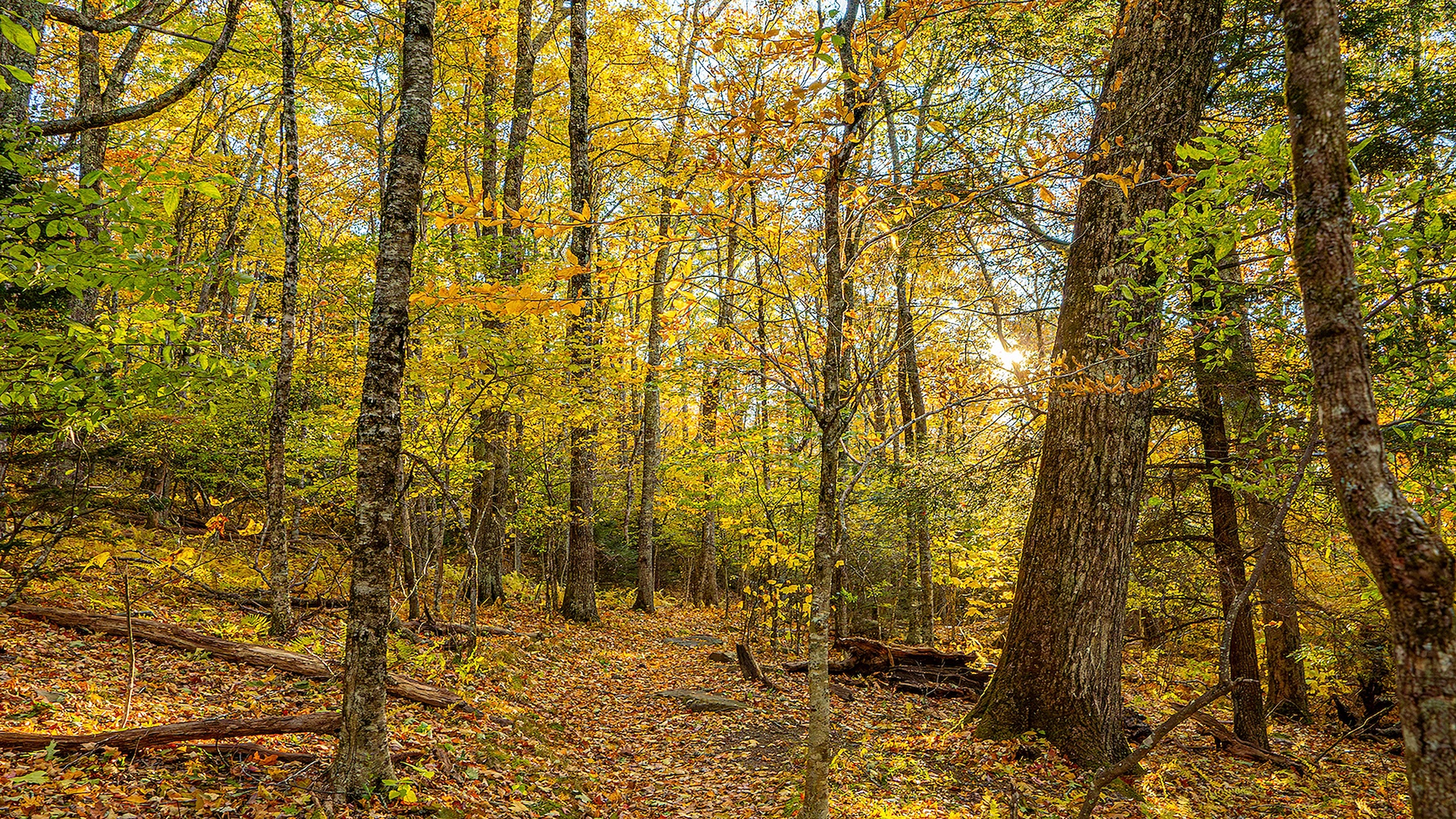
Grandfather Mountain Daily Fall Color Report | Oct. 23, 2023:
Colorful maple leaves frame this image of the Linville River near the Linville Falls Visitor Center. Currently, the best fall color can be seen below 4,500 feet in elevation.
This week’s forecast calls for warmer temperatures, sunshine and pleasant conditions for leaf-looking expeditions.
Photo by Skip Sickler | Grandfather Mountain Stewardship Foundation
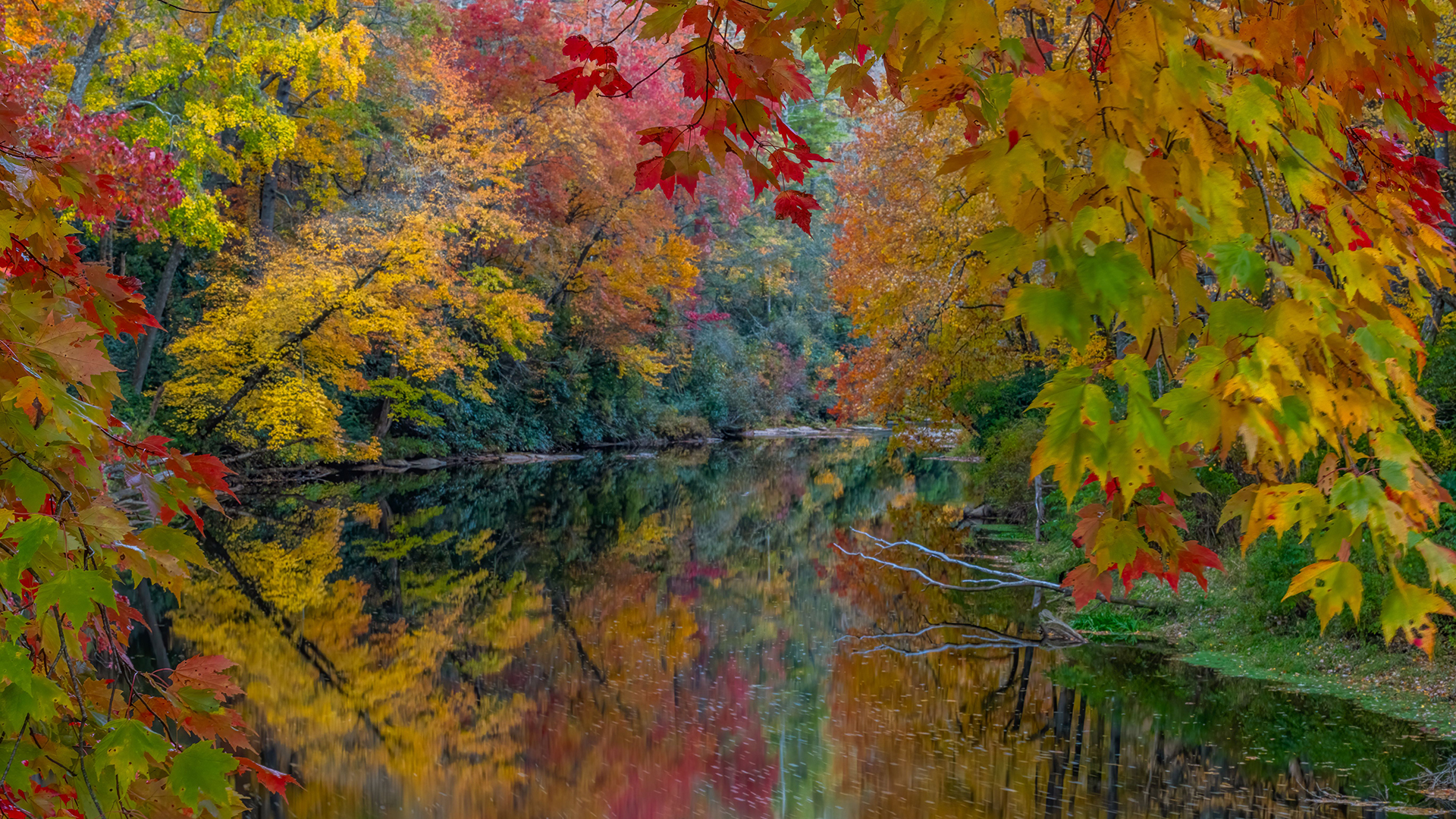
Fall Color Report for the Week of October 22, 2023
Yesterday, Saturday, October 21, started off windy and blustery, with low-lying clouds obscuring the high peaks. But by 11 am, the skies had cleared to become a cloudless deep blue that highlighted the fall leaf colors nicely. But unfortunately, my fall leaf color companion, Dr. Eduardo de Campos, and I headed out early to beat the anticipated crowds, so that when we summitted Elk Knob State Park, we were enveloped in swirling clouds and we did not get the long range views that we had hoped for. Had we gone 1-hour later, we would have been rewarded with views that possibly could have gone as far as 50-60 miles. But, c’est la vie!
But there is a north-facing overlook halfway up the 2-mile trail, and that was below the cloud base, so we did get to see some colors on the landscape. I have to say that I was surprised that they were not yet at peak here, and there were still large areas with green trees. Usually, this view has great color, but it seems 7-10 days behind last year. If you go up later this week or next weekend, the colors should be better from this viewpoint.
The trail up to the top is an easy hike, takes less than 1-hr, and if not cloudy offers great views. You can see as far as Whitetop Mt, Virginia’s second highest peak to the north and down to Mt. Mitchell if looking south, as well as Grandfather Mt, to name but a few of the many peaks visible from the top.
Photos of our Elk Knob hike appended to this posting.
Leaves were past peak from the 1-mile point upward, which are the high elevation trees. Strong winds that previous night and that day took down a lot of maple leaves, leaving a lot of bare branches. There is a nearly monotypic stand of beech at the lower portion of the trail and they were at peak yellow color, with some entering their final leaf color phase, which is a nice bronzish brown color. The hobblebushes were past their peak, so their colors were blasé unfortunately, but when they are on peak, they have an unusual sporadic purpling on their large ovate green leaves which is quite unusual and beautiful. They are clustered in large numbers right around the 1-mile overlook on both sides of the trail.
Although frowned upon, we took the service road down from the top to the place where it first crosses the hiking trail. We did so to find other plants that we may have missed on the regular trail. I don’t recommend doing this, as it is quite steep and rocky and you can easily slip and fall. But we did see some nice views which I have posted. I expect I’ll get a letter of reprimand from the Park for doing this….but hopefully not! It was done for a good cause.
As we left the park around 10 am, it was beginning to get quite crowded and so we decided, given the early hour, to continue our leaf looking by taking a road less traveled, to quote Robert Frost, which in this case was Rich Mt Road, accessible from the Meat Camp road you take from Rt. 194 to get to Elk Knob State Park. Rich Mt. road heads west up to high elevations and after several miles ends up on US 421 at the NC/TN border, west of Boone. It offers spectacular views and we saw great fall leaf colors, and almost no one else was on the road – it was like having the entire mountain to ourselves.
There are homes and estates on this mountain (Sunalei Preserve for example) some of which are restricted communities, but it is worth the drive if you want to head somewhere differen. The road is unpaved for most of its length until you get a few miles from the end, but it’s well maintained and any car can traverse it.
After that ride it was near lunch time so we decided to head back to Boone and get a quick lunch at Taqueria El Paso, which offers excellent Tex/Mex style food. I had torta carnitas (see photo of my huge sandwich, which ended up being two meals it was so large). Highly recommended. It is next to the Ingles Shopping Center on Rt. 105 in Boone.
Then, against all good judgement, we headed to the Blue Ridge Parkway (BRP) knowing that at midday it would be quite crowded with leaf peepers. And indeed, it was – with traffic from US 321 south on the BRP running slowly as people were stopping at the Cone Manor, Julian Price Park, and Price Lake. Once past Price Lake traffic eased up until we approached the Rough Ridge Trail area, which may be the most popular hike on the BRP and always has lots of cars parked on both sides of the BRP.
Anticipating that, we pulled off before getting to the Rough Ridge portion of the BRP into the Boone Fork Parking Area (mile 299.9) and decided to hike up to the Flat Rock view. Neither Eduardo or I had ever been on this trail, and we had no idea how long it was or even where it would take us. We asked several people coming down what there was to see and how long it would take to get to the Flat Rock viewpoint and we received answers that varied in both time and length. But we decided to head up the Scout Trail to see if we could get to the viewpoint. Once you do this, or, if you go the other way on the Nuwati Trail (the hike makes a loop) you enter the east side of Grandfather Mt. State Park. The trails say Permit Required, but that means for camping, not hiking, as we later discovered. It’s about 1.5 miles to the first view, but, not knowing this when we were out on the trail, with the time approaching 4 pm, and the sun rapidly setting, we sadly decided to turn back (a wise decision given how fast the sun was going down). Turns out we were probably within a quarter of a mile of the view! Again, c’est la vie!
Nonetheless, it was a very pleasant hike, mostly uphill, somewhat rocky, moderatly difficult, through very beautiful forest, laden with Fraser magnolias, maples, oaks, and witch hazels. At the upper reaches, you enter spruce forest, and the complexion of the forest changes as a result. I do recommend this hike, but it is strenuous and on the upper reaches of the Nuwati, you’ll have to climb rope ladders on boulders. Pets are not recommended as a result. If you go all the way, you can get to Calloway Peak, one of the highest peaks in the region, but you’re looking at an all-day hike.
After making it back to our car, Eduardo and I headed south toward the Linn Cove Viaduct. We wanted to see how the leaves were after the high winds of the day. You could tell that these winds were blowing lots of leaves off the trees simply by looking down on the forest floor, which during our hikes at Elk Knob and Nuwati, were covered with maple and magnolia and witch hazel leaves. Looking up we saw lots of bare branches. The consequences were obvious as we headed down the Parkway – the fall foliage display was past peak at higher elevations, while it was still excellent at the level of the Parkway, although it was not as vibrant as it was just a few days earlier on Wednesday. If I had to pick “the” day colors peaked at mid-elevations on the BRP, I’d say it was on Wednesday, October 18th.
Winds at peak leaf display can shorten the display period, since the leaves are not held onto the trees as tightly as when they are green and are easily removed. We saw the result of that on Saturday. Winds are still blowing this Sunday morning, so I expect more will have come down overnight. But color was appearing downslope toward the foothills, and I have seen good color in Lenoir and Lincolnton, which are much lower in elevation, so the peak is moving off slope now. This week will still have good color and I encourage you to come up – the weather is supposed to be sunny with comfortable temperatures all the way into next weekend. If colors aren’t peak along the Parkway, they will be showing up at lower elevations which you can view from the overlooks.
This coming weekend I will probably head to Stone Mt. State Park. I usually go there in early November, but I have to be out of town the second week of November, and in Charlotte prior to that, so this will be my only time to visit this park. Stone Mt. State Park has large rock outcrops at elevations of 1500-1800’ and great color when at peak. It’s an easy to moderate hike to the outcrops from the main parking lot, and there is a wonderful waterfall you can visit on the way up. If you have the legs, you can walk down to the bottom of the falls too on wooden steps and boardwalk, which I recommend. When you are on the outcrops and look up, you will be looking at the BRP. That section is closed for construction or otherwise you could get to the park from there. For now, the easiest way to get to this park is off of US 421 in Wilkesboro (use Google maps, as it’s not intuitive how to get there on all those country roads).
I’ve grouped the photos from yesterday’s adventures into four folders and added comments to them to explain what to see if you decide to go to these places. Have a great week!
Grandfather Mountain Daily Fall Color Report | Oct. 22, 2023:
The past week has been spectacular, with more to come as fall colors continue to make their way down to lower elevations. The area around the Linn Cove Viaduct has been especially vibrant this season, attracting thousands of visitors looking to see this engineering marvel surrounded by a kaleidoscope of color.
Photo by Skip Sickler | Grandfather Mountain Stewardship Foundation
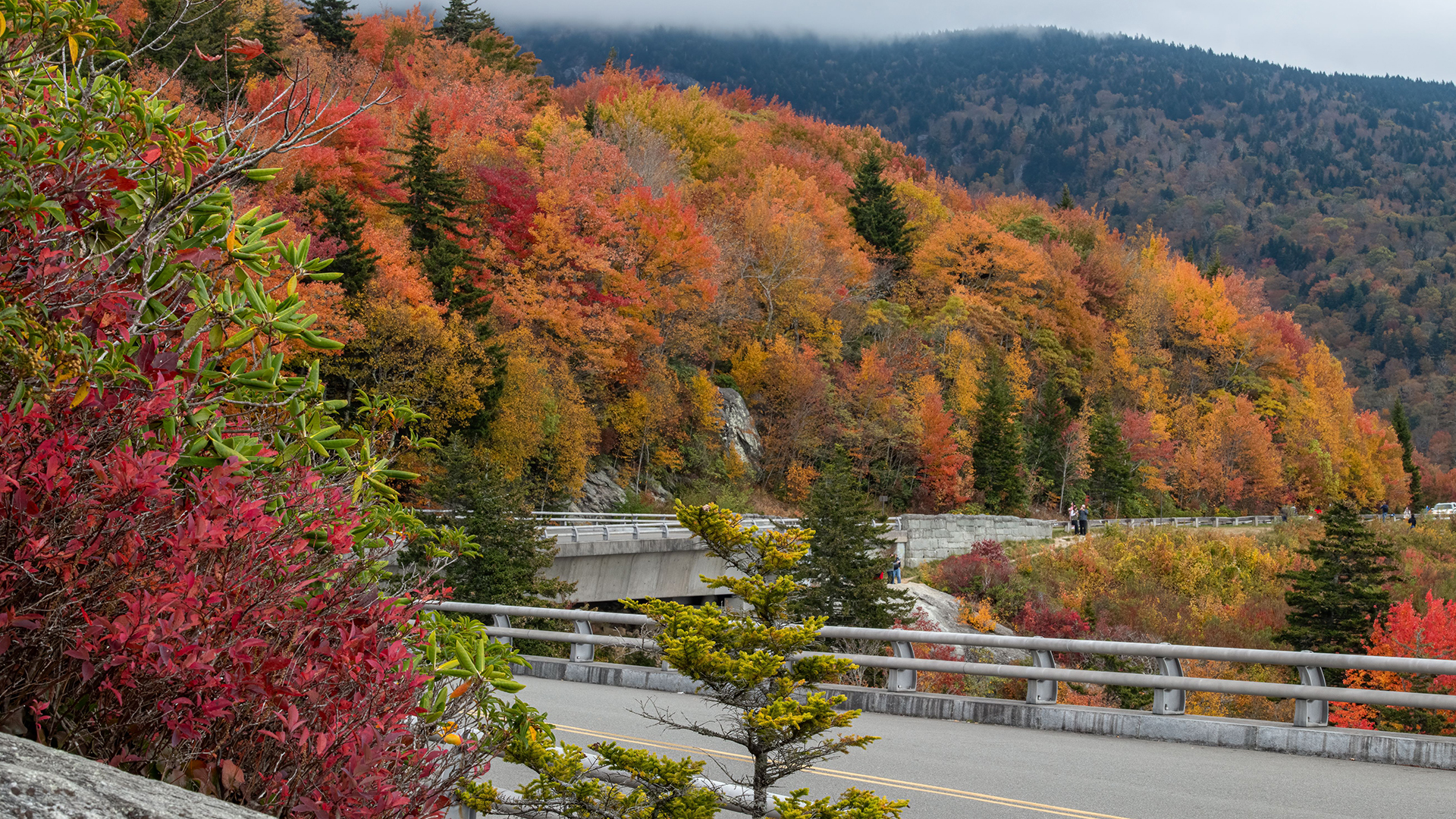
Grandfather Mountain Daily Fall Color Report | Oct. 21, 2023:
Grandfather Mountain’s many hiking opportunities provide a uniquely immersive fall color experience. This image from the Black Rock Trail shows golden autumn hues strikingly contrasted against the green rhododendron leaves below.
2023 was named the “Year of the Trail” in North Carolina, and today, Oct. 21, is designated as the inaugural Great Trails State Day. Grandfather Mountain offers access to over a dozen miles of walking and hiking trails.
Photo by Leslie Restivo | Grandfather Mountain Stewardship Foundation
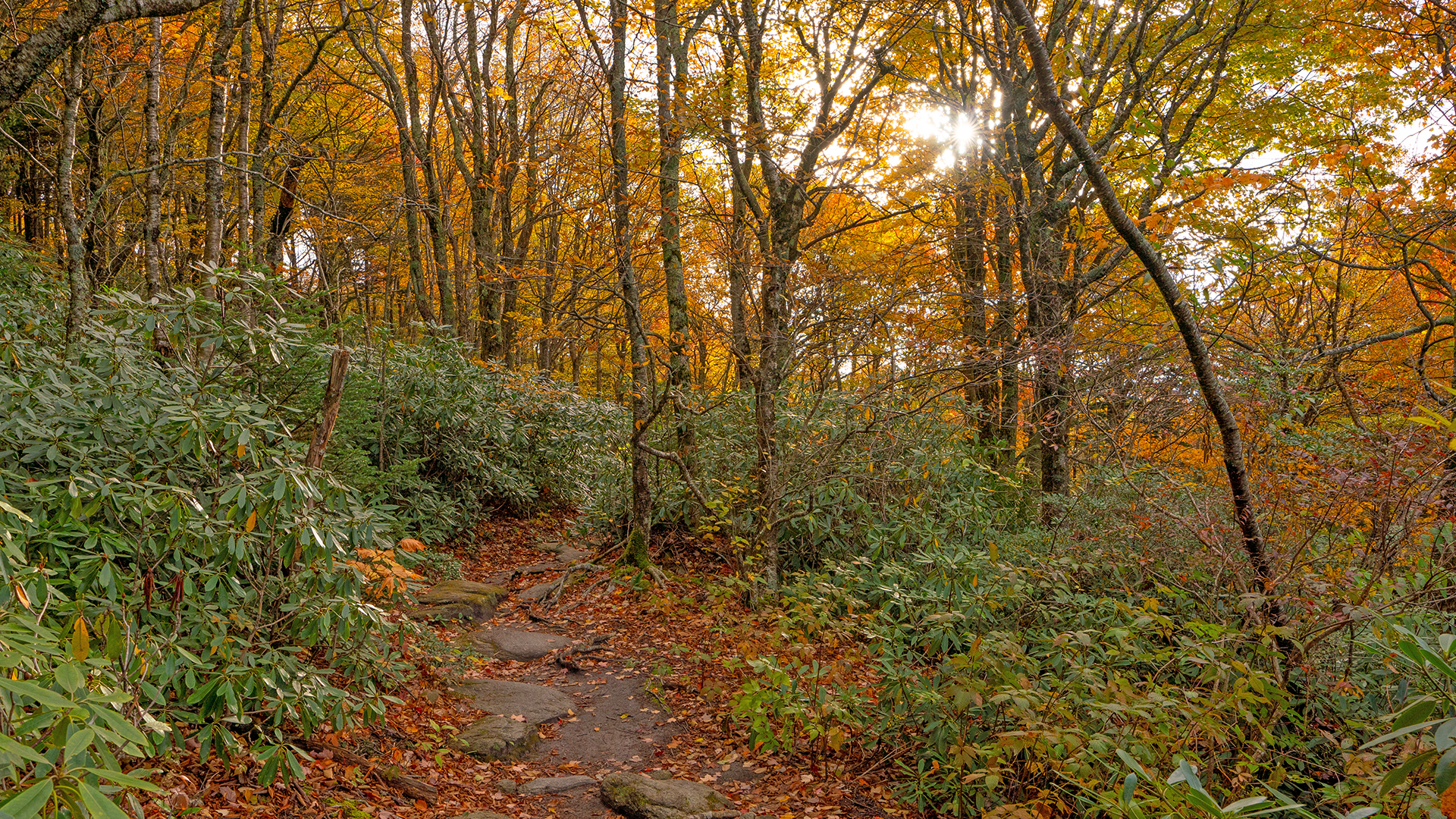
Grandfather Mountain Daily Fall Color Report | Oct. 20, 2023:
Fall color beautifully fills this shot of the Historic Mill Pond in Banner Elk, showcasing a serene autumn setting. While today’s (Friday’s) forecast calls for occasional rain, the skies should clear for most of the weekend. The area’s foliage is exceptionally vibrant right now for those planning their leaf-looking trips.
In addition to the Woolly Worm Festival in Banner Elk on Saturday and Sunday, the Valle Country Fair is taking place Saturday in Valle Crucis. There is no shortage of fall fun to be had in the N.C. High Country this weekend!
Photo by Skip Sickler | Grandfather Mountain Stewardship Foundation
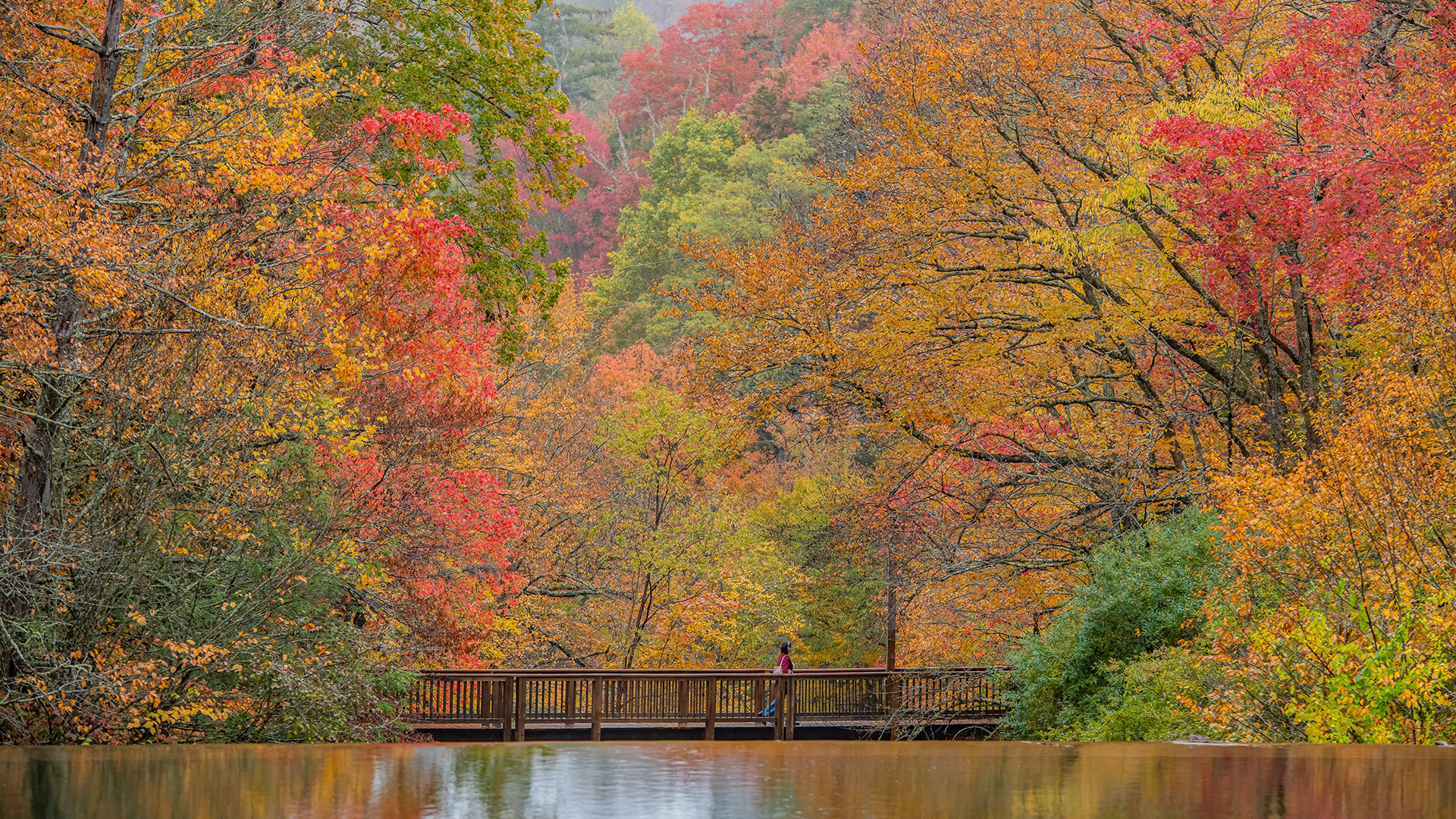
Grandfather Mountain Daily Fall Color Report | Oct. 19, 2023:
The Historic Cheese House in Banner Elk plays off the surrounding autumnal tones. The structure, built in 1917 and originally home to an award-winning cheddar cheese operation, is now owned by Lees-McRae College.
The 46th-annual Woolly Worm Festival takes place in Banner Elk on Saturday and Sunday. This event, paired with the spectacle of fall color, should make for an exciting and busy weekend in the N.C. High Country.
Photo by Skip Sickler | Grandfather Mountain Stewardship Foundation
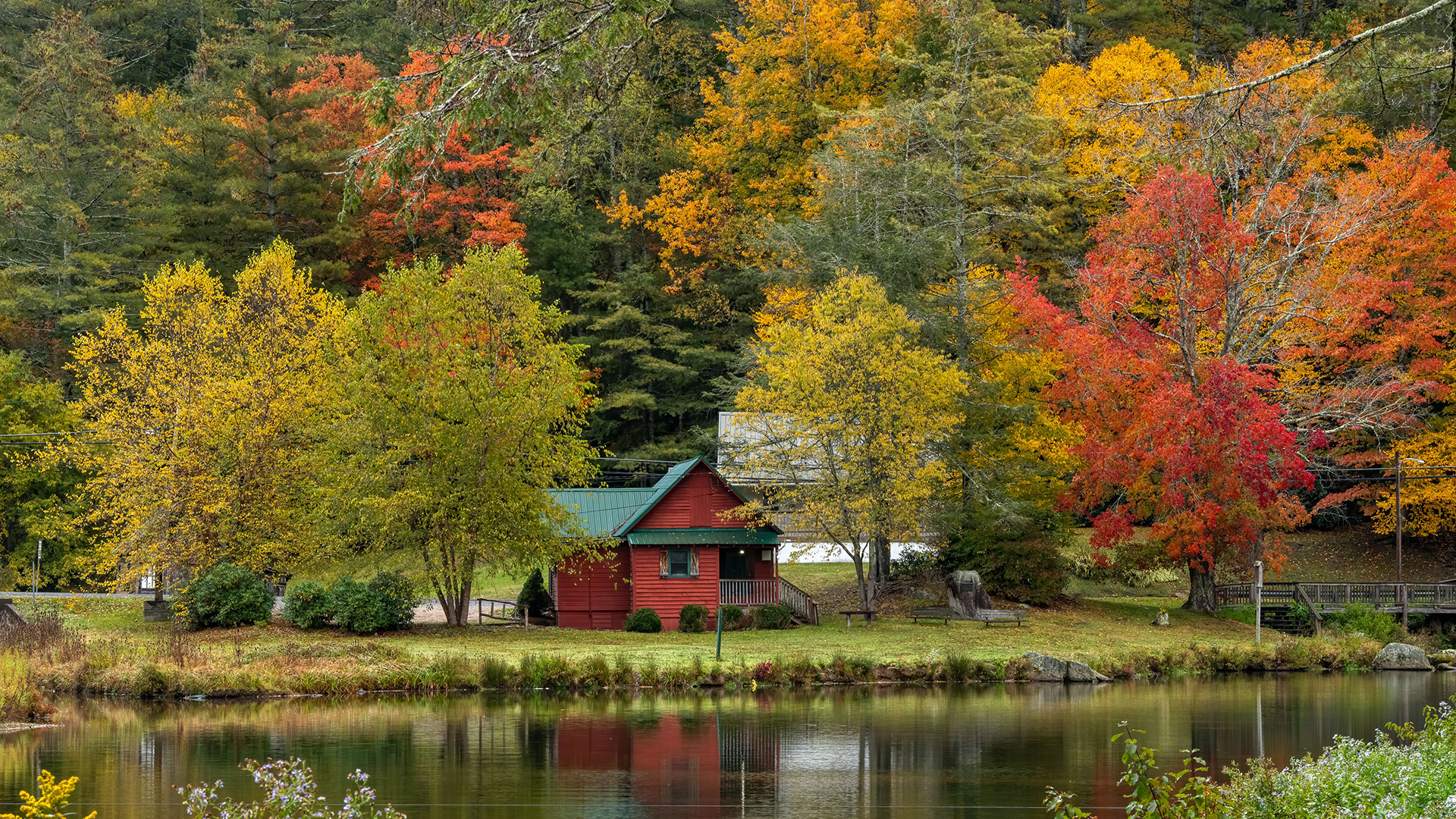
Grandfather Mountain Daily Fall Color Report | Oct. 18, 2023:
Fall foliage on the mountain remains exceptionally colorful as the surrounding vistas get increasingly vibrant. Colors are currently the best above 3,500 feet.
The Mildred the Bear Environmental Habitats provide another perspective of autumn hues, as seen in this image from an overlook at the bear habitats. The color show can also be enjoyed from the cougar and elk viewing areas.
Photo by Leslie Restivo | Grandfather Mountain Stewardship Foundation
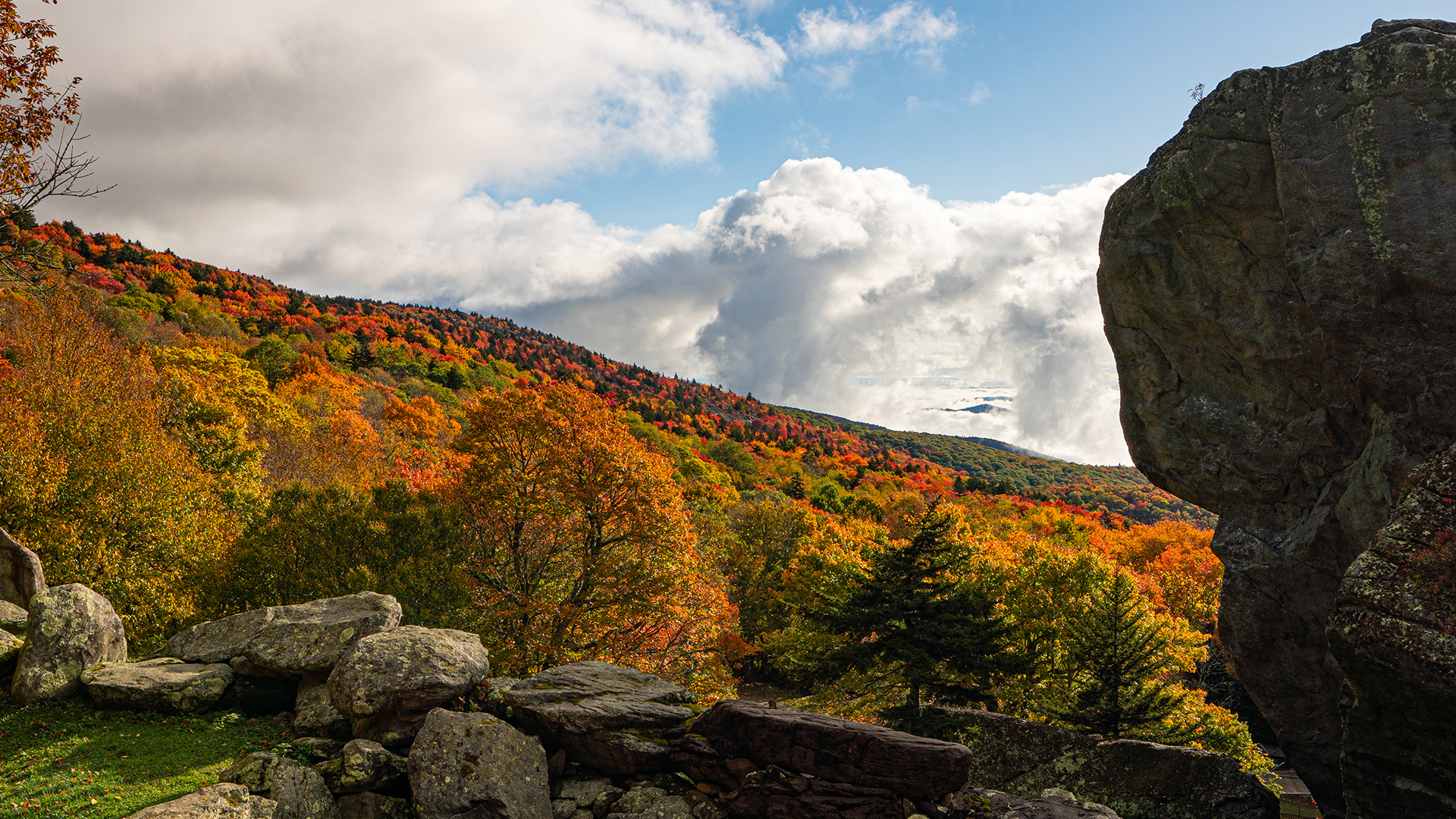
Grandfather Mountain Daily Fall Color Report | Oct. 17, 2023:
This stretch of the Blue Ridge Parkway around Grandfather Mountain is really showing off a vibrant blend of fall colors this week. The scene displayed in this photo is a long-distance view of the very popular Rough Ridge, which can be accessed from a trail at Milepost 302.8.
Though clouds linger today, overcast skies can make fall colors pop against the landscape. Sunshine is forecasted to return on Wednesday and Thursday.
Photo by Skip Sickler | Grandfather Mountain Stewardship Foundation
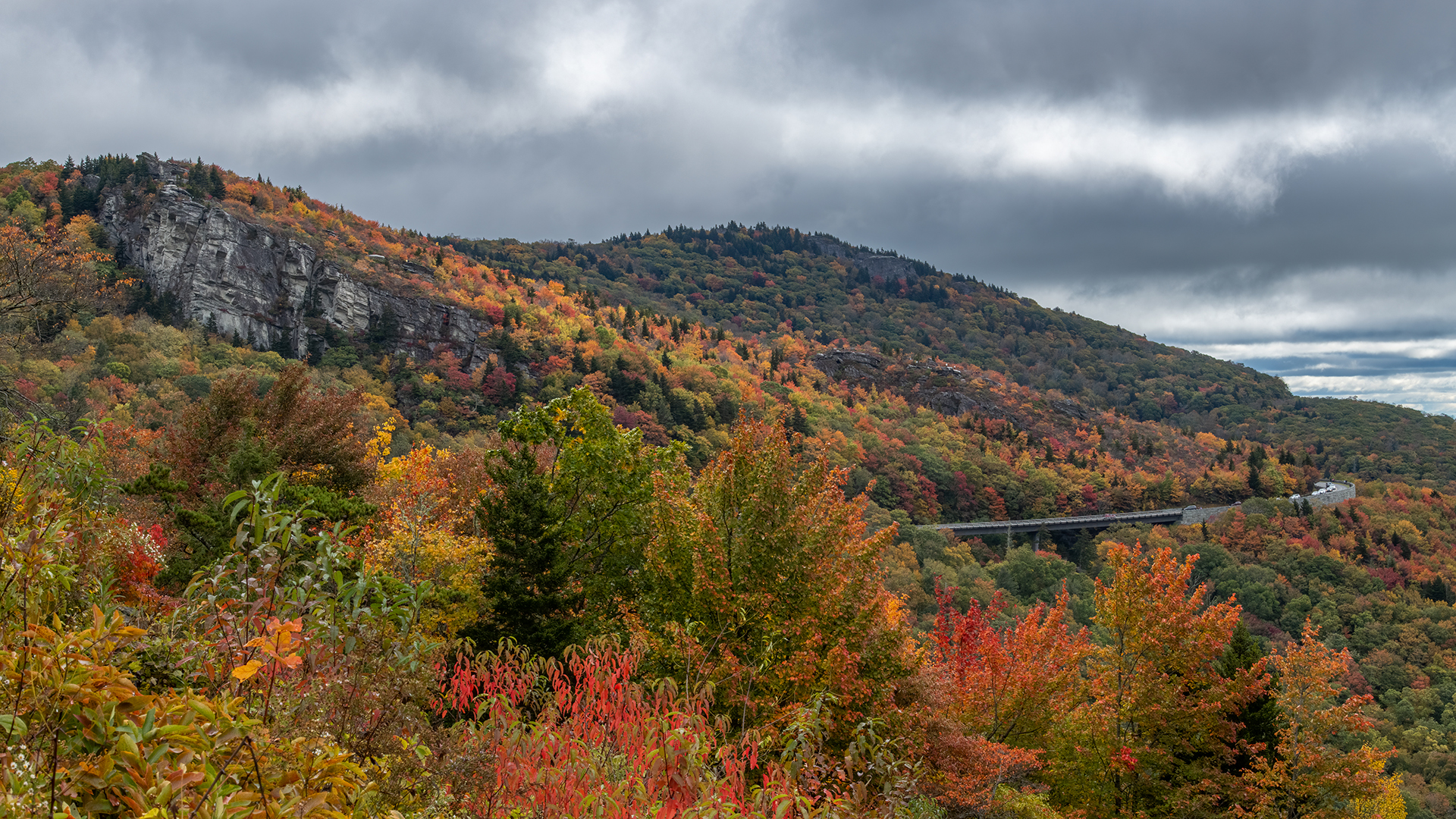
Grandfather Mountain Daily Fall Color Report | Oct. 16, 2023:
Color has really ramped up across the area in the last few days, as seen in this iconic view of the Linn Cove Viaduct from U.S. 221. The surrounding towns of Linville, Blowing Rock, Banner Elk, Beech Mountain and Boone are all great locations to see widespread and vibrant color.
This photo was taken on Sunday. Today is a chilly day in the N.C. High Country, with light snow, rime ice and wind chills in the teens at the highest elevations of Grandfather Mountain.
Photo by Skip Sickler | Grandfather Mountain Stewardship Foundation
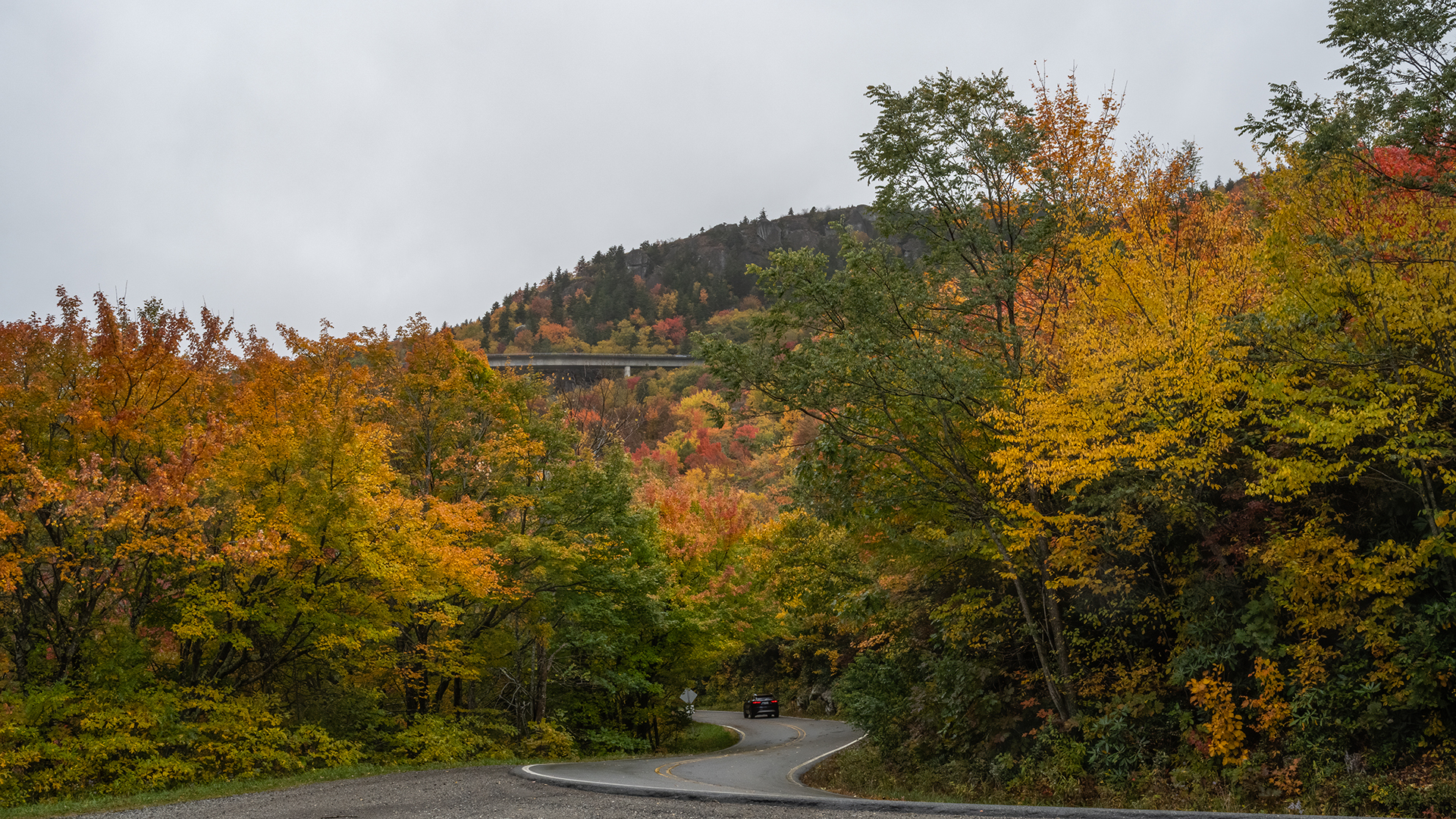
Fall Color Report for the Week of October 14, 2023
Today started off in mist and drizzle, although it was relatively warm. We almost canceled our trip because of the dreary conditions, but seeing light off to the northeast where we were headed spurred us on and that turned out to be the right decision, as the day consistently got better weather wise and by the afternoon we had partly cloudy skies with occasional bright sun.
Today’s fall foliage reporters became a trio that included myself, of course, plus my wife Claudia, and my companion for the last two weeks, Eduardo de Campos. Having the three of us tromp through the forests looking at fall colors and taking photos was a most pleasant way to spend an autumn Saturday!
We headed out US 421 east from Boone to Deep Gap so we could get on the Blue Ridge Parkway (BRP), intending to go to Jeffress Park and Cascades Falls, but the BRP is closed in that section due to road construction, so we weren’t able to reach the park. Instead, we headed up US 221 to West Jefferson and then to the top of Jefferson State Natural Area, which is just a 1-mile drive from the highway. There are several overlooks along the way up and you could, if you wanted, hike up to the top, but we chose to drive all the way up to the picnic area at the summit.
Attached to this posting are pictures from Jefferson State Natural Area, near West Jefferson, NC. In the next post will be photos from Doughton Park.
Once there, you can take an easy 1-mile loop trail to Luther Rock (halfway out) where you’ll have great views to the northeast and southeast. Mt. Jefferson is nearly 5,000’ high at the top, so it is definitely cooler up there and the colors are more vivid at that high elevation right now. This place is definitely going to peak over the next week or so, and it’s currently colorful enough now to plan a trip there.
Jefferson State Natural Area has trees one routinely associates with the mid-Atlantic states like MD or PA, and include black, red, and white oaks (Quercus velutina, Q. rubra, and Q. alba), American chestnut (Castanea dentata), lots of red, sugar, and striped maples (Acer rubrum, A. saccharum, and A. pensylvanicum), plus beech (Fagus grandifolia) and cucumber and Fraser magnolias (Magnolia acuminate and M. fraseri). This is because of the high elevation of this mountain, and probably also the type of soil too. A few ash (Fraxinus sp.) are scattered here and there, along with the vine Dutchman’s Pipe (Aristolochia macrophylla). Right now, the maples are the most colorful up there, while the American chestnuts are morphing past peak, but still with plenty of yellow and brown leaves. Cucumber magnolia and beech are mostly still green, as many of the oaks, but they will color up over the next two weeks.
When you get to Luther Rock, you have great views off to the NE and SE. Then, you can take a loop trail which runs just below the crestline back to your car. This is a very easy hike and there are also plenty of picnic tables to have a nice outing there. Colors were much more advanced than I expected, so the coming week and next should be great for foliage color here.
After our hike, we decided to get some lunch in West Jefferson. We selected “The Tavern” restaurant, based on a recommendation from a friend, and were surprised to learn that today was its last day in business. New owners are taking over and renaming it the Red Dog, and it will become a bar and grill, as we understand. Nonetheless, we all had a great meal there, after which we headed toward Doughton Park in Allegheny County, north of Ashe County.
Because the BRP is undergoing considerable road construction, long stretches of it are closed to traffic. We headed out of town on Rts 18/88 South for about 20 miles or so, through very pretty countryside, before getting on the BRP about 7 miles south of Doughton Park. In this area, the only section open goes from where the BRP intersects Rt. 18, north to the Brinegar Cabin, where it closes again. If you are coming up from eastern NC on US 421, get off the highway in Wilkesboro and take Rt. 18 N. About 30 -45 minutes later or so, you’ll reach the BRP and can head north toward Doughton Park.
Doughton Park is several thousand acres in size and has plenty of trails and overlooks. We stopped at the Bluff Mt. trailhead and hiked up to the overlook, which took us about 20 minutes of easy hiking. The elevational increase is about 400’ and in the steep parts near the top the NPS has installed wooden stairs. Once at the top you have excellent views to the southeast and southwest.
There is also a dense stand of witch hazel (Hamamelis virginiana) adjacent to the rock outcrop (to the north). This shrub has leaves that turn a dull yellow with brown streaks, and it flowers in October, which is quite unusual. A cold-tolerant moth may pollinate the shrub, but so might flies and bees. The question of who pollinates this late flowering shrub is still ripe for study (https://grownativemass.org/…/The-Pollination-Puzzle-of…). See also this article (https://bygl.osu.edu/node/1751).
When we finished our viewing, we headed over to the Wildcat Overlook, about a mile from the Bluff Overlook (you could walk from one location to the other, but we chose to go in our car). The Wildcat Overlook offers one of the most spectacular views of anywhere on the BRP. If you look down the nearly 1000’ drop off, you can see a wood cabin in the valley below (see photo I took of it, using 30X mag on my Pixel 7 phone!). This is the Caudill Cabin. For years, I thought it was the Brinegar Cabin, but was corrected by the person in the store at the visitor’s center, which is located right on the BRP. The Brinegar Cabin is 2.5 miles past the visitor’s center going north, and is as far as you can go before the road closes again due to construction.
The Brinegar’s lived in a two-room cabin in the area about 100 years ago. Their descendants, and those of the Caudill’s, often get together on the BRP for reunions, according to the park personnel we spoke with today. Given the isolation of both cabins: e.g., 5.5 miles on a dirt road to any sort of human influence for the Caudill cabin, and perhaps a similar trek for the Brinegars to wherever they needed to go. You can drive right to the Brinegar’s cabin. If you want to visit the Caudill cabin, be prepared for a 5.5 mile hike to the cabin, and then 5.5 miles back (11 miles roundtrip!).
As it was now getting late, we headed back to West Jefferson, but instead of taking US 221 to US 421 back to Boone, we got off US 221 just south of West Jefferson onto Rt. 194 and headed from Ashe into Watauga County. This road, a scenic drive, goes through some very rural countryside with great views of fall foliage (which is looking very good right now and will be even better later this week into next weekend). I highly recommend this road as you can see some nice fall colors as you drive back to Boone.
Next week we are planning a trip to the summit of Elk Knob State Park just north of Boone. There is an easy 2 mile hike up with views in all directions at the top, which is over 5,000’ in elevation. The forests to the north of the Park always have great fall color, even in bad years, so we are hoping for colorful views next weekend.
Colors should develop rapidly this week, as temperatures are going to drop 20-30 degrees by Monday (there is even a prediction of snow flurries on Monday). It’s quite windy outside my home as I type this in the early evening, and I’m hoping it doesn’t take down too many leaves. Those that are still green will be fine, but for leaves on trees that have colored up this week, it could blow them off. Since we still have a lot of green trees, I think we’ll have great color into this week and next.
Here’s hoping you have a good rest of the weekend!
Grandfather Mountain Daily Fall Color Report | Oct. 15, 2023:
The drive along the Blue Ridge Parkway between Linville and Blowing Rock remains one of the best routes to see autumnal tones. This view offers the additional treat of fall color reflecting off of Price Lake. Grandfather Mountain is also mirrored in the water, as seen in this photo taken last week.
The colder temperatures expected for the next few days should continue fall’s widespread reach over the region. This week should be an especially nice time to go on fall adventures in the N.C. High Country.
Photo by Leslie Restivo | Grandfather Mountain Stewardship Foundation
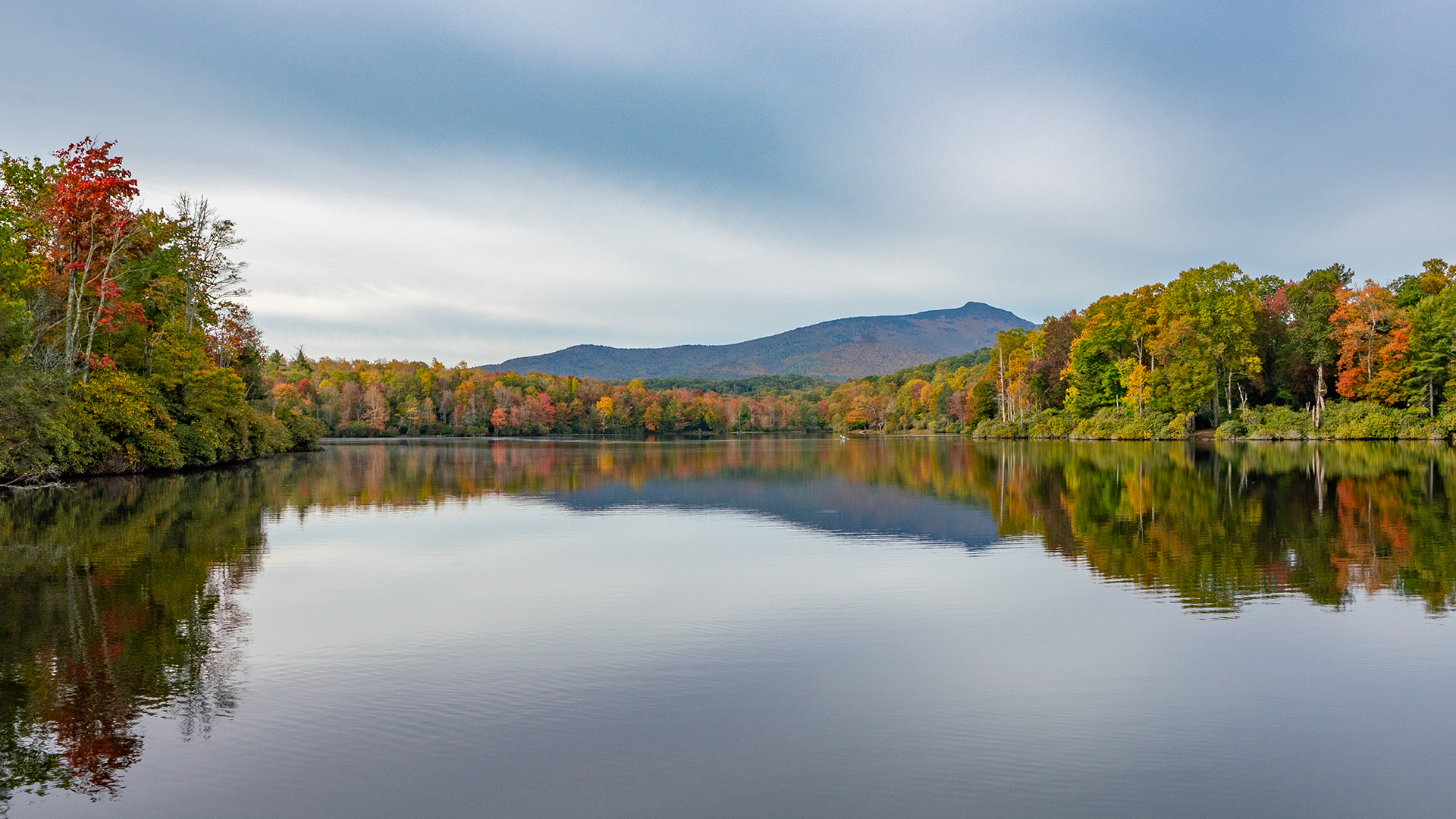
Grandfather Mountain Daily Fall Color Report | Oct. 14, 2023:
Color is widespread on the mountain, including in nearby MacRae Meadows, as seen in this photo taken earlier this week. Grandfather beautifully blends a landscape of rock faces and granite cliffs, the dark-green hue of evergreens and a kaleidoscope of fall colors.
Although light showers are forecasted for this (Saturday) morning, the day overall should still be great for fall color viewing.
Photo by Skip Sickler | Grandfather Mountain Stewardship Foundation
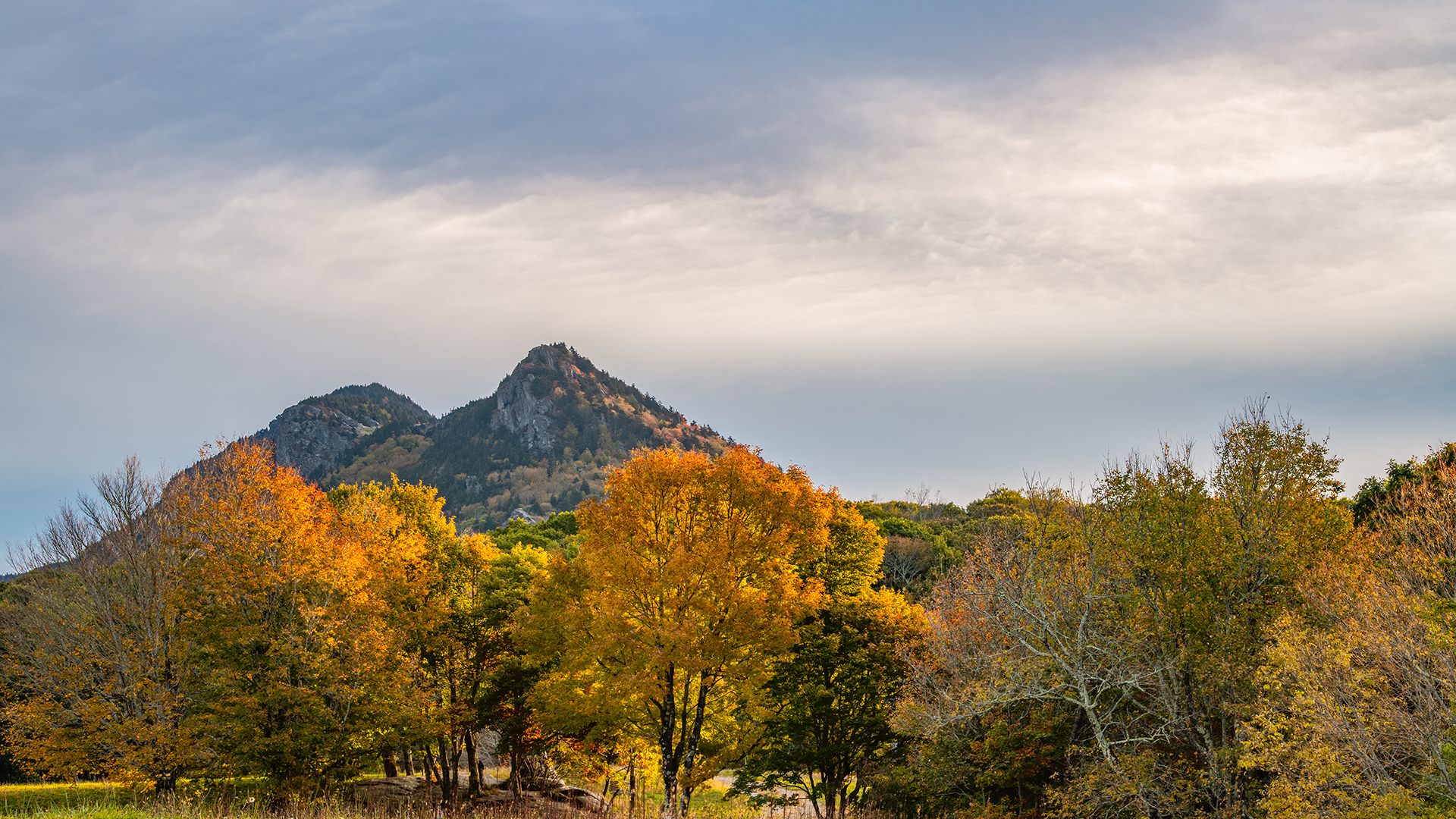
Grandfather Mountain Daily Fall Color Report | Oct. 13, 2023:
Cliffside Picnic Area and Overlook provides this unique vantage point looking up at Linville Peak, with fall foliage and the rich red hue of mountain ash berries brightening up the shot. This spot is just one of a dozen picnic areas in the park. These sites are located in some of the mountain’s most picturesque settings and offer an array of scenic views.
Today (Friday) would be a perfect day for an autumn picnic, with nice weather expected and the fall color progressing nicely.
Photo by Leslie Restivo | Grandfather Mountain Stewardship Foundation
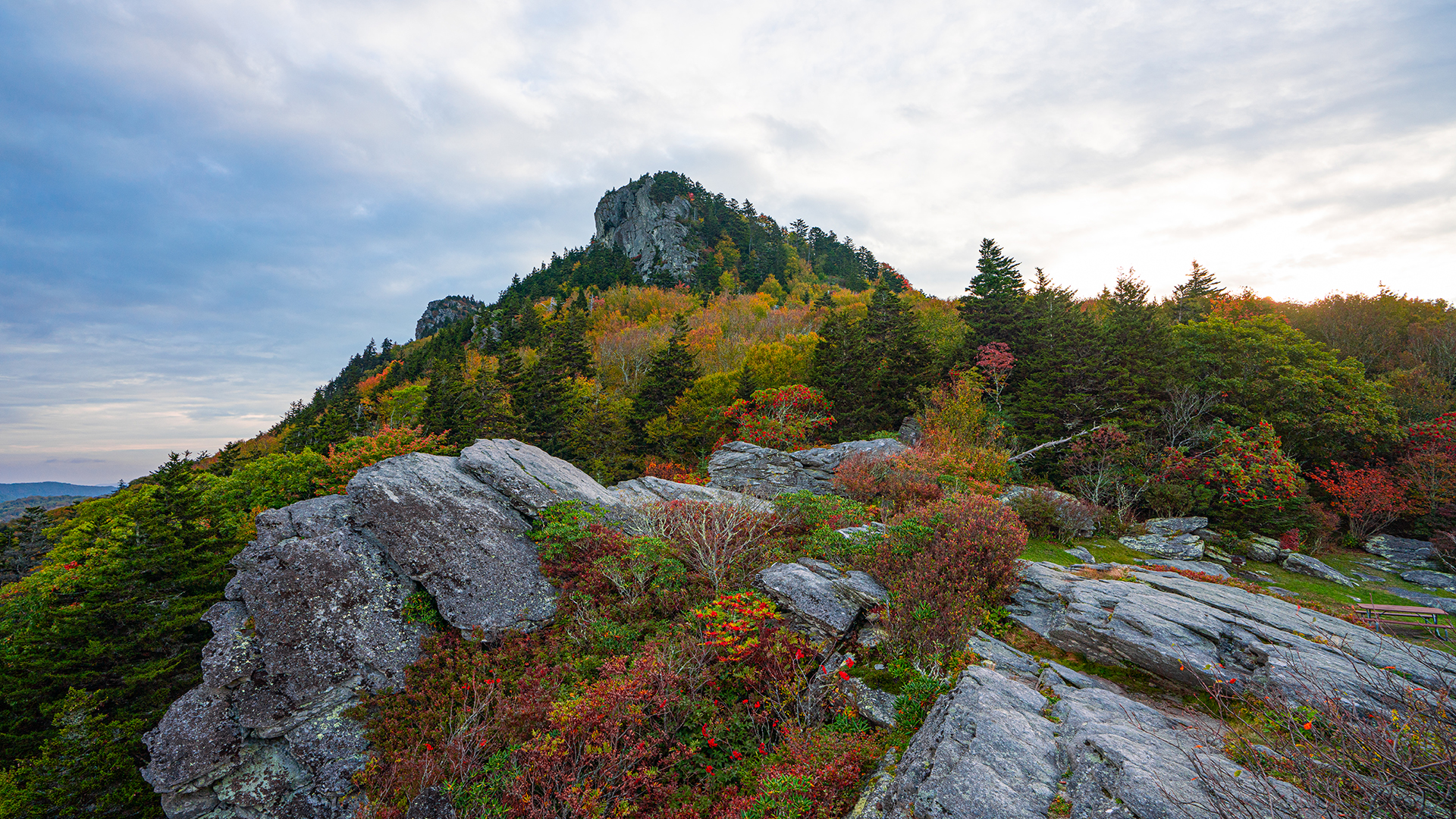
Grandfather Mountain Daily Fall Color Report | Oct. 12, 2023:
This long-distance shot of Grandfather Mountain’s Mile High Swinging Bridge (and Top Shop building, on the right) was taken from the Blue Ridge Parkway, near Green Mountain Overlook, at Milepost 300.6. The red, yellow and orange hues set against an evergreen backdrop are becoming more and more vibrant.
The weather conditions for Friday should be pleasant for leaf-peeping adventures in the area, with scattered light rainfall forecasted for over the weekend.
Photo by Leslie Restivo | Grandfather Mountain Stewardship Foundation
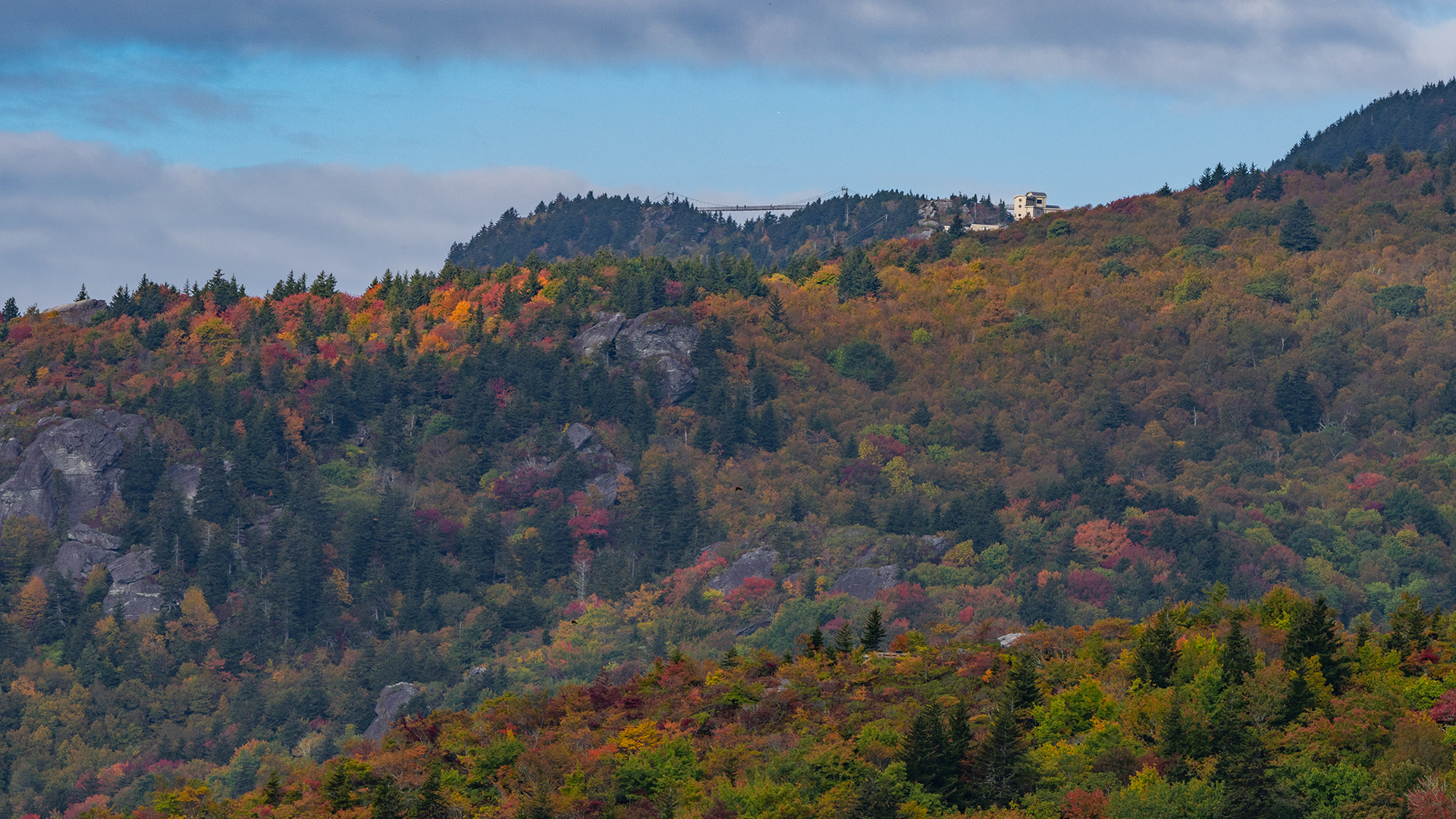
Grandfather Mountain Daily Fall Color Report | Oct. 11, 2023:
Though the mountain and surrounding areas have not yet reached their peak, more autumn hues are covering the landscape each day. Linville Peak’s lofty vantage point makes it one of the best places in the N.C. High Country to enjoy a fall view. Throughout the season, this location, on the far end of the Mile High Swinging Bridge, remains an ideal spot to take in the color progression as it makes its way down to lower elevations.
Photo by Leslie Restivo | Grandfather Mountain Stewardship Foundation
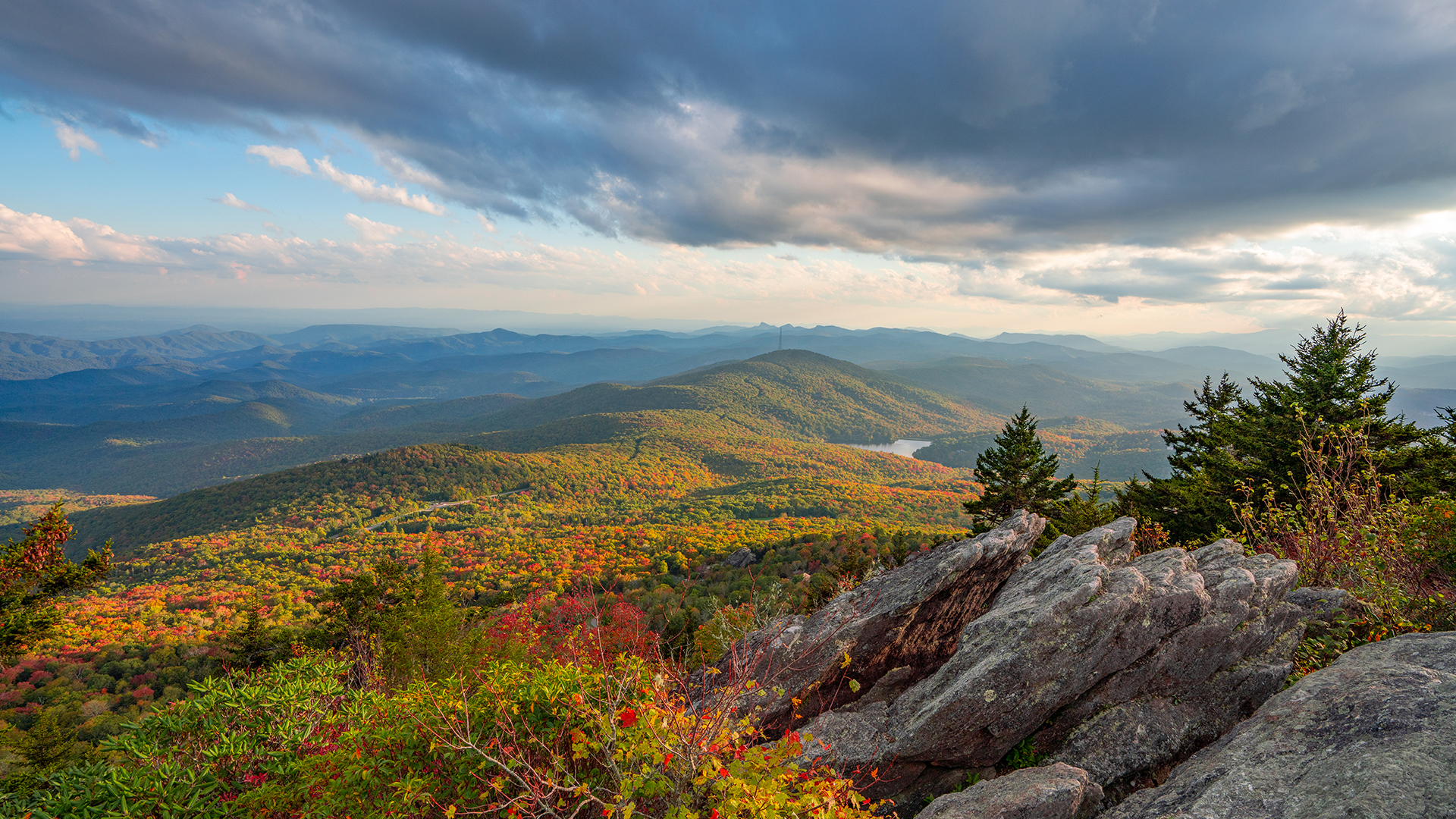
Grandfather Mountain Daily Fall Color Report | Oct. 10, 2023:
Bright hues of witch hazel highlight this iconic view of Forrest Gump Curve on the drive up to the top of Grandfather Mountain. Witch hazel is among the many seasonal plant species that also brighten up the fall color landscape. Likewise, unique and colorful in this area of the park right now are the red berries of mountain ash and the yellow flowers of goldenrod.
This vantage point can be found at Cliffside Overlook.
Photo by Leslie Restivo | Grandfather Mountain Stewardship Foundation
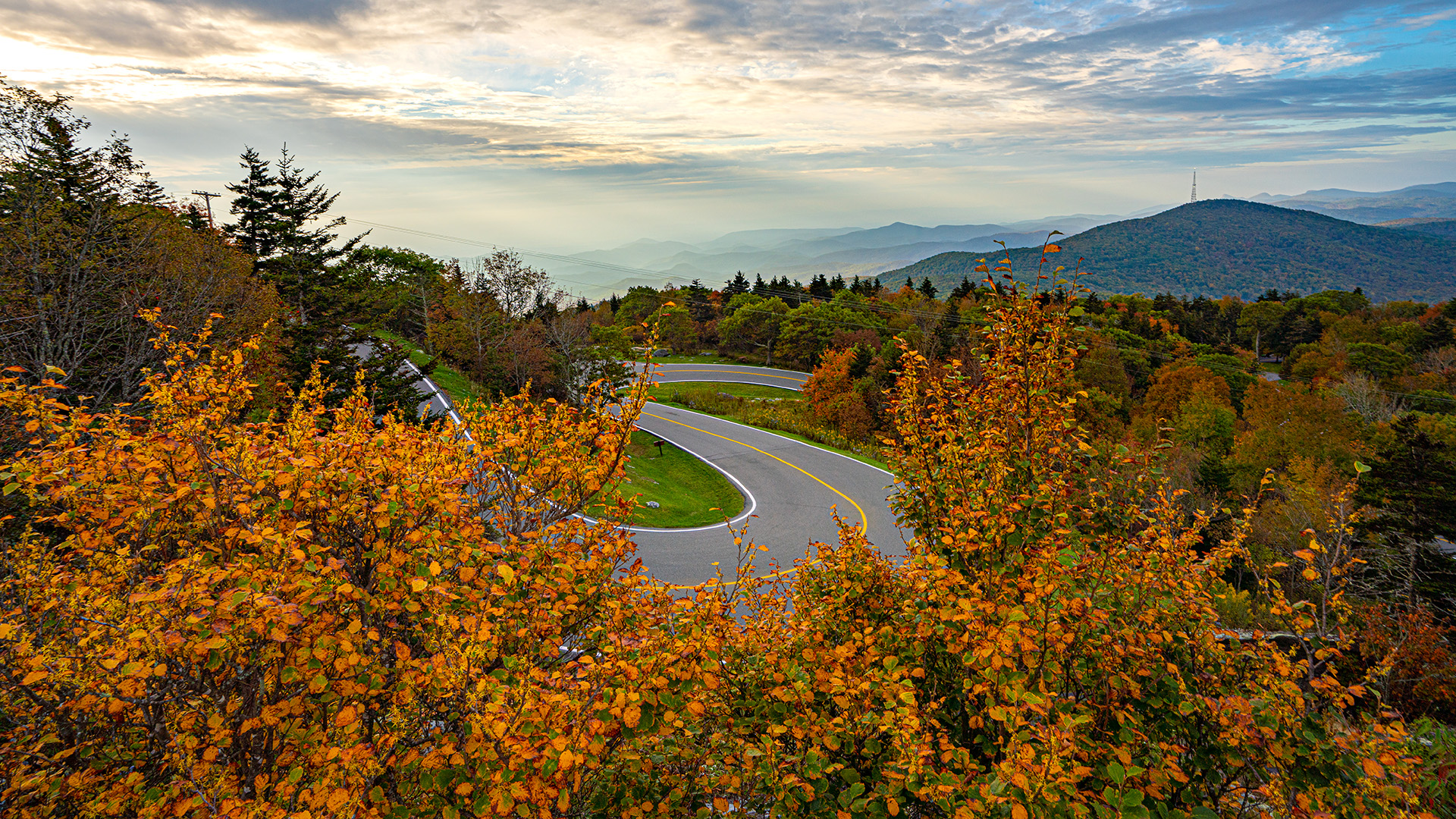
Grandfather Mountain Daily Fall Color Report | Oct. 9, 2023:
The park road at Grandfather Mountain provides a nice snapshot of the current landscape. While some vibrant trees and pockets of color dot the hillsides, there is still much to come. Overall in the region, a lot of green remains.
This view from the switchbacks near the top of the mountain shows the entrance of the Bridge Trail across from the Black Rock parking lot.
Photo by Skip Sickler | Grandfather Mountain Stewardship Foundation
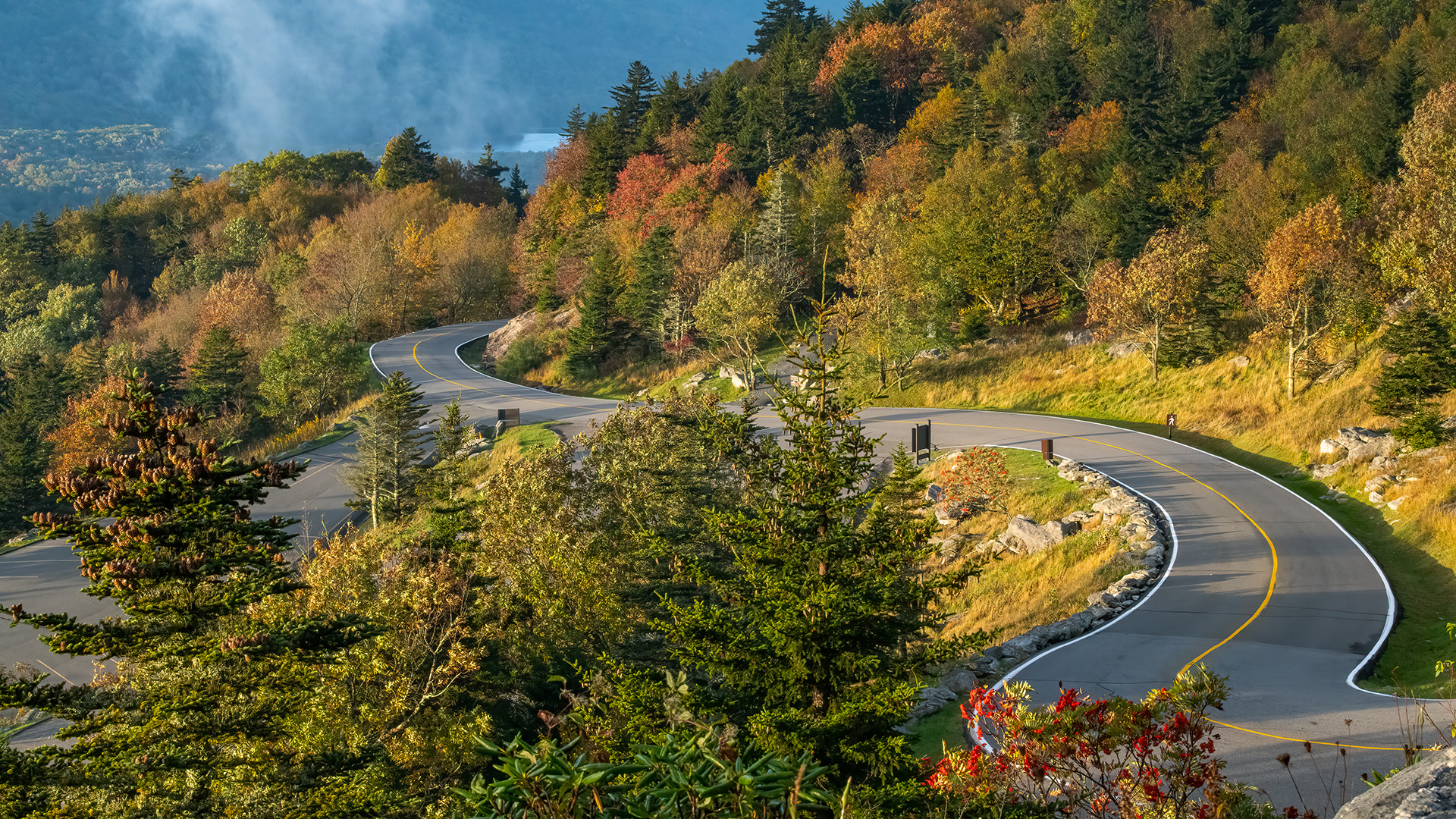
Fall Color Report for the Week of October 8, 2023
I posted about my trip on Friday with WXII-TV meteorologist James Scott yesterday, along with photos of my hikes on the Rough Ridge Trail and the one that goes to the Linn Cove Viaduct alongside the Blue Ridge Parkway (BRP). Today, I provide some more photos of my trip with my colleague Dr. Eduardo de Campos, who was making his first visits to all these locations. Eduardo comes to us from Brazil and is a 2nd year professor of chemistry at Appstate.
In this posting I provide pictures from our trips to Wisemans View in the Linville Gorge Wilderness Area and Linville Falls (photos in a separate posting from this one) and in this posting our trips to Beacon Heights and Grandfather Mt. We had a superb day on Saturday, with abundant sunshine, cool, comfortable hiking temperatures, and a stiff but bracing wind up at the Mile-High Swinging Bridge (it actually is 5,280’ above sea level)!
The maples and black gums are providing the majority of the red colors now, along with some sourwoods, dogwoods, and various shrubs such as Vaccinium and Gaylussacia (blueberry and huckleberry, respectively). Tulip poplars (Liriodendron tulipifera) and Fraser magnolias (Magnolia fraseri) are turning rapidly now to yellow; tulip poplar leaves can become bright yellow, then they turn black and fall off, while the large Fraser magnolias start off a dull yellow before morphing over to a nice chocolate brown color. Birches are also coloring up as are American chestnuts (both turn yellow).
A cold front moved in late Saturday and temperatures today (Sunday) never got higher than 48F, which is great for stimulating color development on the trees. We’ve needed a good drop in temperatures to get colors going, since last week had above normal temperatures. The 10-day forecast says that the Boone area won’t get out of the 50s until Wednesday, then stay in the 60s, before rising to 71F late in the week, after which temperatures are supposed to drop again. These are near perfect conditions for good color development. There could be some rain late Saturday or Sunday, but lots of sunshine the rest of the week. This bodes well for good fall foliage color! My only worry is if there are strong winds, as they could knock off leaves if they are highly colored, because such leaves are not held onto the tree as tightly as those that are still green.
Based on these weather predictions, I am suggesting that color will develop rapidly this week on into the following weekend, and continue into the following week. Thus, our peak for the 3,000-4,500’ elevational range will most likely occur between Oct 13-20, which would put us on-time this year. Whether it will be as vibrant as last year, which was probably the best in the last 15 years, is anyone’s guess. We know more about timing than vibrancy.
So, where to go this coming week? The BRP from Blowing Rock to Chestoa Overlook (4 miles south of the US 221 intersection) is a good drive with great views. This includes a variety of hiking trails of varying difficulty and of course, GF Mt (reservations required!). The section from Graveyards, below Asheville, all the way to the Smokies would be good too, and there are campsites, waterfalls, hiking and plenty of overlooks along this stretch, which ends in Cherokee, NC in Great Smoky Mountains National Park (GRSM). It may be slightly ahead of peak color at the lower elevations in GRSM, but higher up should have color. Be aware that this most visited park, with some 14 million visitors per year, can get extremely crowded, especially on weekends, so plan accordingly.
Doughton Park and Jeffress Park (which has Cascades Falls) in the northern section of the BRP (north of US 421) are also good for hiking and views, but you have to check ahead of time for road closures on the BRP in that section. This website (https://www.nps.gov/…/blue-ridge-parkway-begins-major…) shows a map of the road closures in North Carolina from the VA line down to the Linn Cove Visitor Center. The three major road closures are all north of US 421 and you’ll have to take detours to visit places in this part of the BRP.
Finally, Elk Knob State Park (just north of Boone) and Jefferson State Natural Area (adjacent to West Jefferson) are two places worth checking out this coming week. Colors should be approaching peak at Elk Knob and nearly so at Jefferson Natural Area. It’s an easy two-mile hike to the top of Elk Knob, with views in all directions, while you can drive to the top of the Jefferson State Area, and then take a short hike along the ridge to some great views at the end, and then loop back to your car. Enjoy!
Grandfather Mountain Daily Fall Color Report | Oct. 8, 2023:
Very nice pockets of color are developing around the Linn Cove Viaduct, the iconic bridge that winds around Grandfather Mountain. Today’s forecast looks favorable for a scenic autumn drive along this stretch of the Blue Ridge Parkway between Grandfather and Blowing Rock.
Fall foliage in the region is at its best above 4,500 feet in elevation, though this weekend’s colder temperatures could spur the color development on.
Photo by Skip Sickler | Grandfather Mountain Stewardship Foundation
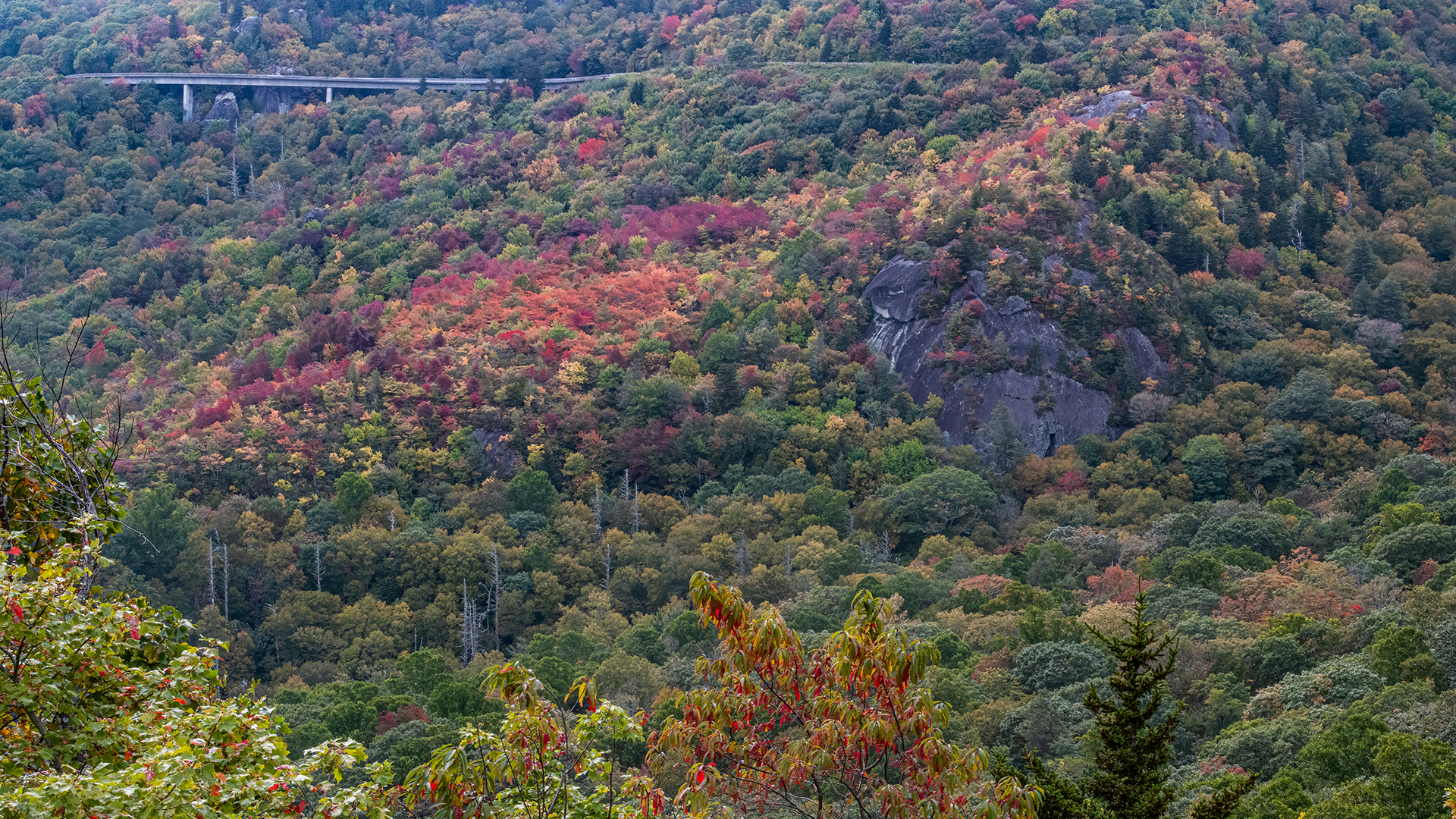
Fall Color Report for Oct 6-2023
Yesterday (Friday) I went out with James Scott from WCCB-TV in Charlotte to talk about fall leaf colors. The link to the report is included here.
https://www.wccbcharlotte.com/…/forecasting-foliage…/
We went to the Rough Ridge Trail just north of the Linn Cove Viaduct, one of the most popular trails on the Blue Ridge Parkway (BRP). As expected, for a Friday as we near peak color, it was crowded. Nonetheless we took off and did the interview on the boardwalk that is about 1/3 of the way up.
The day was partly cloudy, but began to clear just after we finished the interview. Leaf colors are developing nicely in this area, and some patches of forest were at peak color. I don’t know why these patches of forest are way ahead of the majority of the forest, but perhaps the soils differ in those patches, or maybe the species of tree. No matter what the cause, it happens every year. I need to hike down into the patches to get an up close look at what’s going on in them!
As you might notice from the attached photos, color saturation is quite high on a cloudy day, and photos of leaf color come out exceptionally good on such days. The main trees that are turning now are sassafras (Sassafras albidum) which can be all colors from yellow to orange to red; black gum (Nyssa sylvatica), which turns a deep red color; Quaking aspen, I think (Populus tremuloides) which turns a bright yellow, sometimes tinged with red; Mt. Ash (Sorbus americana) with bright red berries and yellow/orange leaves; red maple (Acer rubrum) with brilliant red leaves; Fraser magnolias (Magnolia fraseri) yellow then brown. There are many more species, too numerous to name, although if they are in the photos, I’ll provide their names there.
Forests are coloring up nicely now and you will be rewarded with nice views over the next two weeks. A cold front moved in today, dropping the temperatures some, but not as much as I would like, though it should be enough to prod the trees on. I think color will continue to improve to next weekend and will peak the week after that (Oct 13-20) in the 3-4,500’ elevational range.
After the interview with WCCB, I hiked up to the top of Rough Ridge, then headed south on the Parkway and hiked alongside the road to the viaduct, since that short walk has such great views.
In my next posting, I’ll fill you in on my visit today (Saturday, Oct 7) to several locations, including Wiseman’s View in the Linville Gorge Wilderness Area, Linville Falls, Beacon Heights, and Grandfather Mt.
Grandfather Mountain Daily Fall Color Report | Oct. 7, 2023:
One of the best places in the park for spotting fall foliage right now is from the area in front of the Wilson Center for Nature Discovery. This view looking up toward Linville Peak showcases a variety of seasonal colors contrasted with evergreen trees.
If visiting this weekend, guests can expect to see the most color at the Wilson Center and above. Views also remain nice from the Mile High Swinging Bridge and other high vantage points on the mountain. The weekend will be a chilly one at Grandfather, so pack your jacket!
Photo by Skip Sickler | Grandfather Mountain Stewardship Foundation

Grandfather Mountain Daily Fall Color Report | Oct. 6, 2023:
Fall vibrancy continues to ramp up in the High Country, as seen in this image looking toward neighboring Grandmother Mountain from the end of the Black Rock Trail.
This coming weekend calls for sunshine and optimal conditions to view autumn hues at the highest elevations of Grandfather and nearby on the Blue Ridge Parkway.
With colder temperatures expected, we recommend bringing extra layers on your leaf-looking expeditions.
Photo by Leslie Restivo | Grandfather Mountain Stewardship Foundation
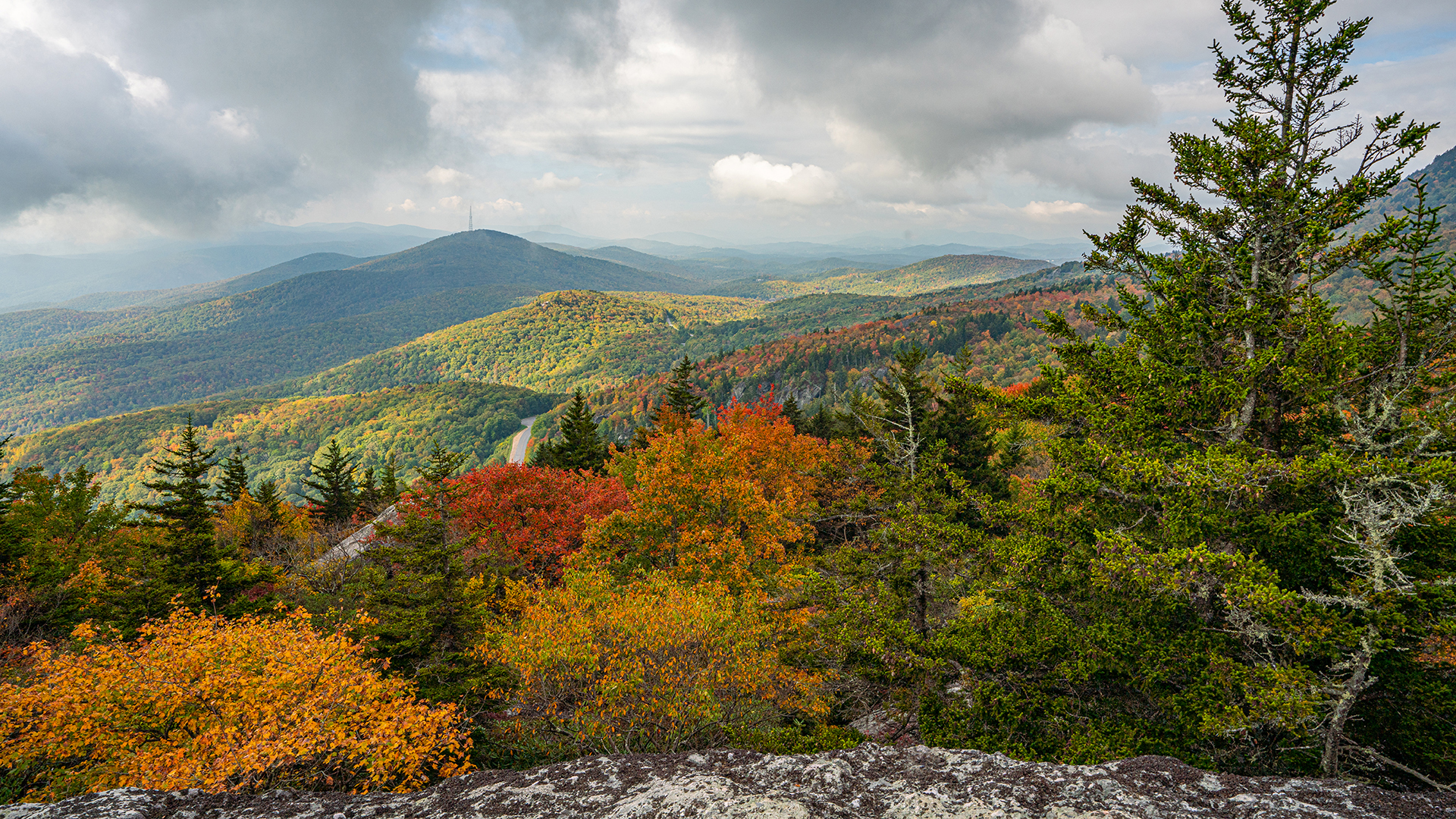
Grandfather Mountain Daily Fall Color Report | Oct. 5, 2023:
Fall color is filling the landscape of Grandfather’s upper reaches, as seen in this image looking up at Linville and Morton Peaks.
While there is still a lot of green on the mountain, the transition to autumn hues is progressing from one day to the next. Colder temperatures are expected to move in this weekend and may cause the process to quicken.
Photo by Skip Sickler | Grandfather Mountain Stewardship Foundation
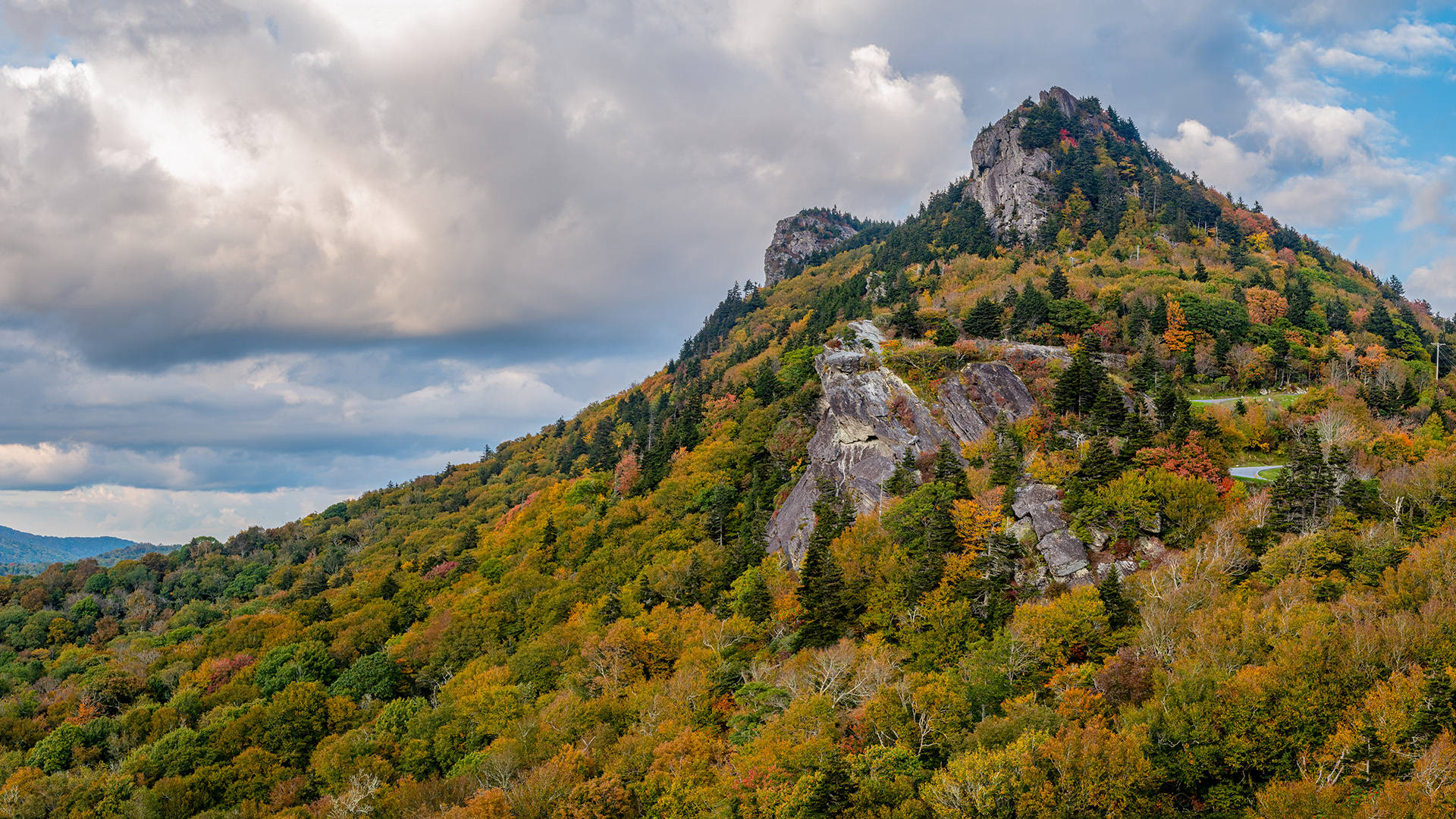
Grandfather Mountain Daily Fall Color Report | Oct. 4, 2023:
This sunrise photo was taken from the Mile High Swinging Bridge, which provides the perfect vantage point for viewing the autumn hues.
Pictured is a spot (in the middle of this photo) that turns early every year and exhibits particularly vibrant fall color. This area, between Grandfather Mountain and the Blue Ridge Parkway, usually changes first because it is a heath bald and the associated shrubs transition before the trees that surround it, making it pop amid the landscape.
Photo by Leslie Restivo | Grandfather Mountain Stewardship Foundation
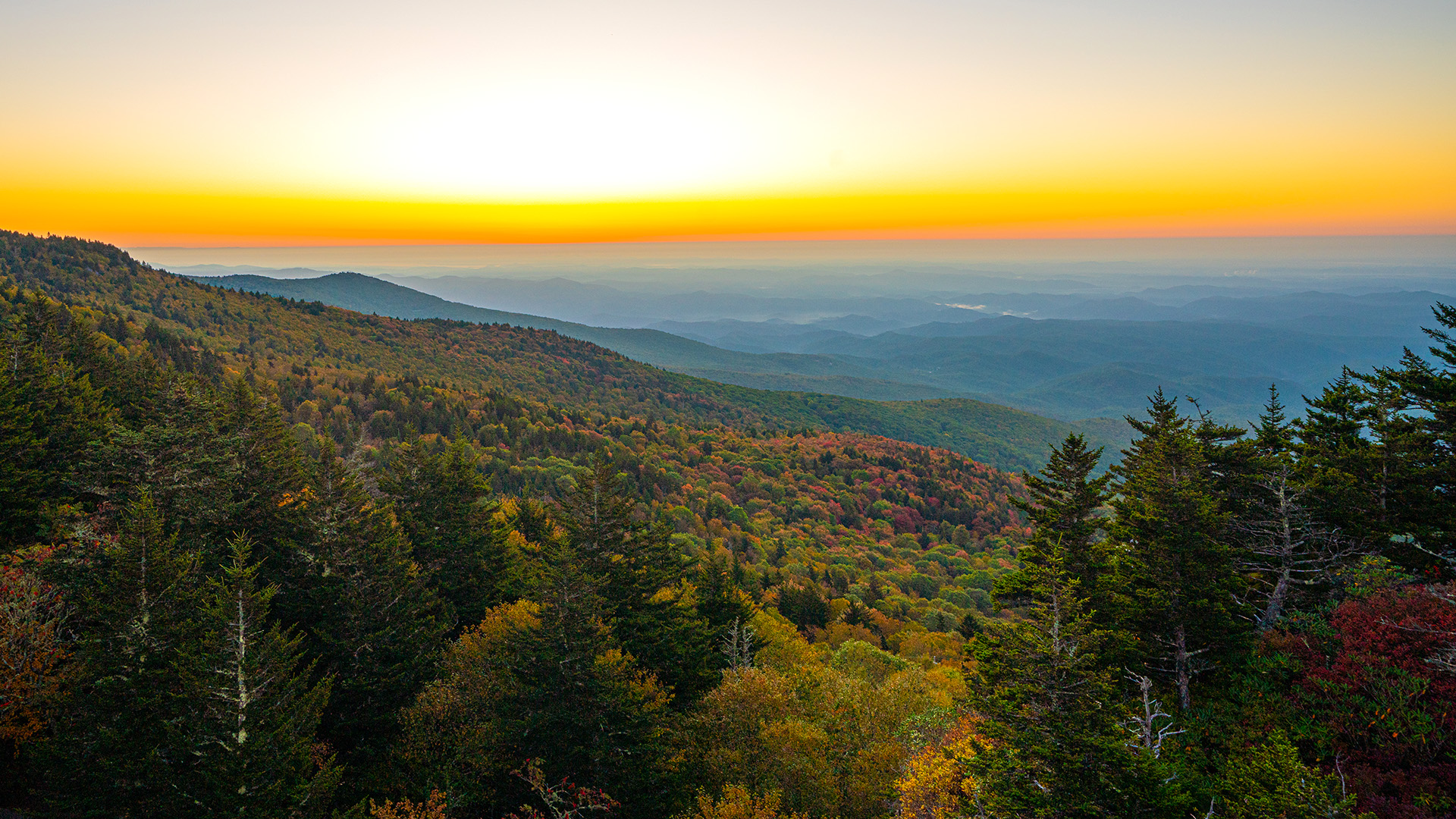
Grandfather Mountain Daily Fall Color Report | Oct. 3, 2023:
Fall color continues to emerge at the highest elevations of Grandfather Mountain. This photo was taken from the end of the Black Rock Trail looking toward the Wilson Center for Nature Discovery.
The park’s daily Fall Color Ramble, happening this week, begins at various locations around the Wilson Center. Focusing on the science behind fall color, these guided walks start at 1 p.m. and are included with admission.
Photo by Leslie Restivo | Grandfather Mountain Stewardship Foundation
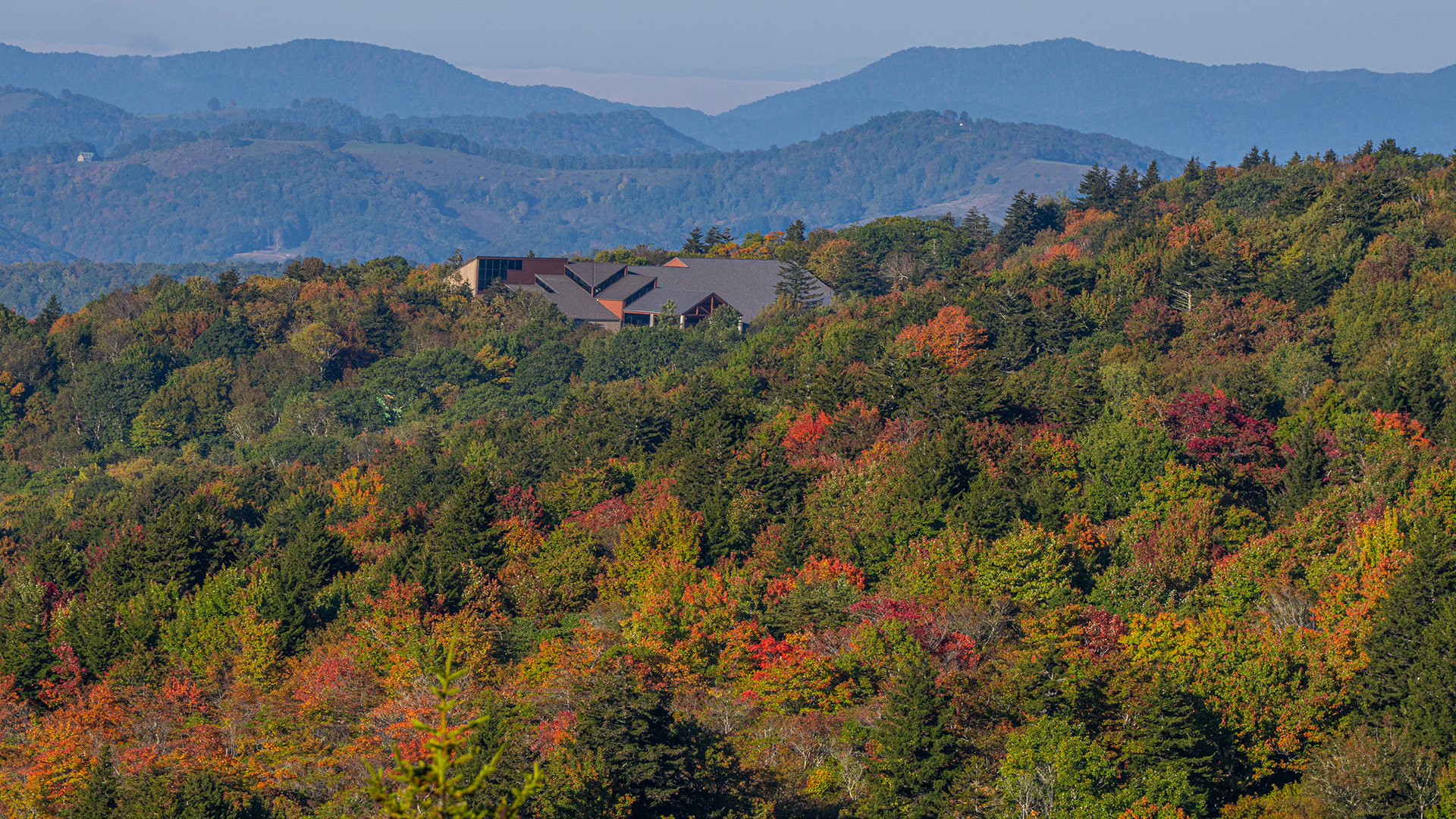
Grandfather Mountain Daily Fall Color Report | Oct. 2, 2023:
Hints of fall color are appearing in the N.C. High Country, especially at higher elevations, as seen here in this photo of Grandfather Mountain taken from the Blue Ridge Parkway. The area has experienced many sunny days and cool nights the last few weeks, prompting the seasonal transition.
While some pockets of color and certain trees are very vibrant at the moment, the overall landscape is still mostly green. The weather forecast for the week looks pleasant for those wanting to get the first glimpses of fall.
Photo by Skip Sickler | Grandfather Mountain Stewardship Foundation
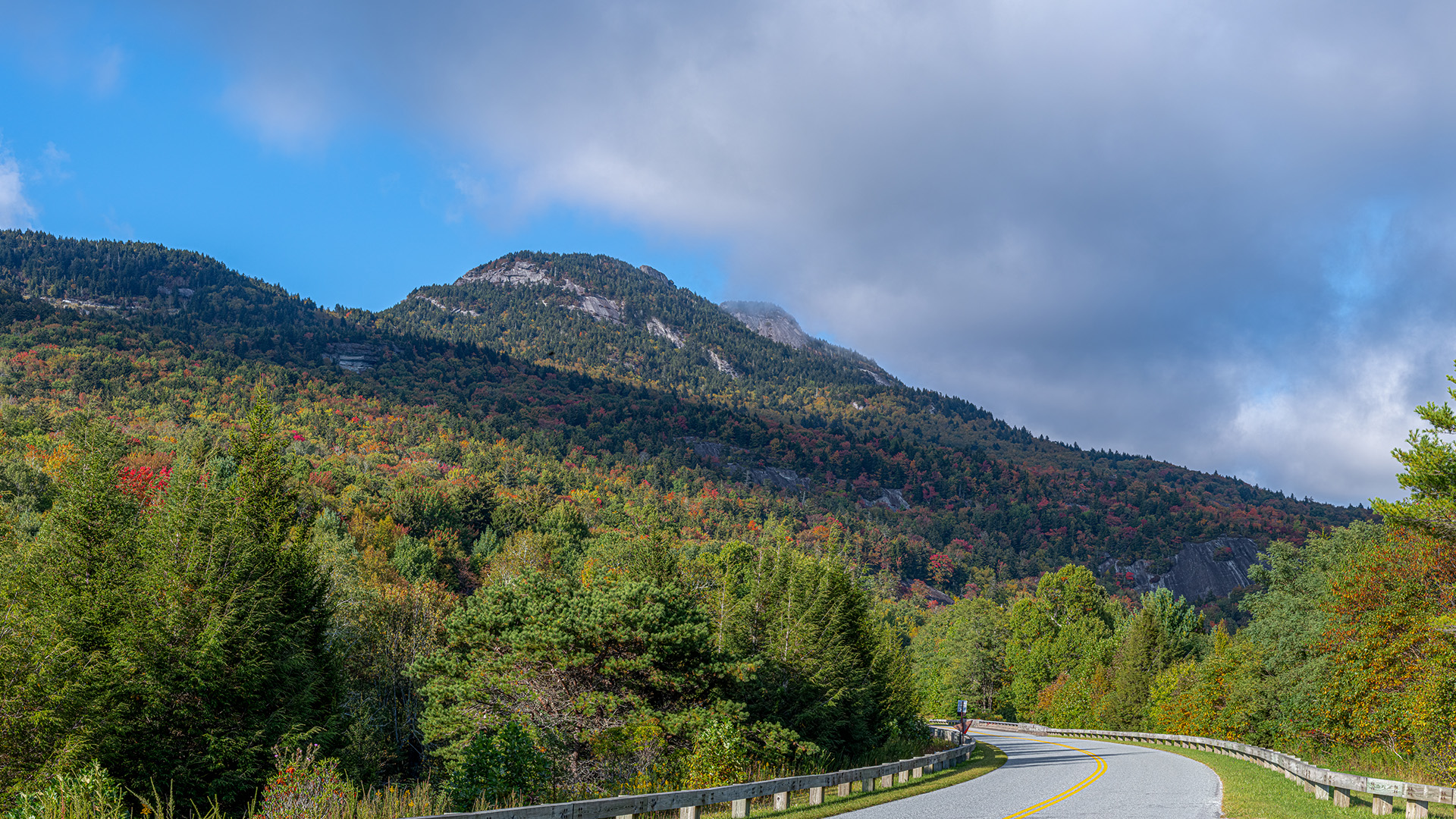
Fall Color Report for the Week of Oct 1, 2023
This week I traveled to Roan Mountain on the NC/TN border along with a colleague from the Chemistry Department at Appstate, Eduardo de Campos, who hails from Brazil. This was his first foray to the mountain and also to the Blue Ridge Parkway.
Roan is an easy drive from Linville, NC (about 35 minutes) and about 1 hour from Boone. Just head into TN from Elk Park, NC on US 19E, turn left at the sign for Roan Mountain State Park, and 10 miles or so later you’ll get to Carver’s Gap at the top. There is parking at the Gap and a rest room. Begin your hike by heading north on the Appalachian Trail (on your left as you come up the mountain).
The best hike is to head out for about two miles, going past Jane Bald and heading up the tall mountain past that point to the monument on the rock. From there you can see Grandfather Mountain and the Linville Gorge Wilderness area, and to your right Mt. Mitchell. Not too hard a hike, although there are significant portions with a lot of uphill climbing, and it is rocky in parts. But well worth it!
I’m happy to report that above 4,000’ elevation colors are coming along nicely. Based on the amount of color that I saw here and along the Blue Ridge Parkway (which we took on the way home), forests are about 25% colored up now, with a few places more than a third colored. Next weekend should be great for foliage viewing and even the next week after that.
The weather has warmed up this week, but because the skies are clear, temperatures drop significantly at night. But the forecast is calling for a significant decrease in temperature by the second week in October, with highs in the 50s and 60s, which means 40s and 50s at the higher elevations. as a major cold front moves in. Temperatures could drop into the 30s at night. That will speed up the development of color and so far, we are still looking at a fall color season that is on time. It may also be a vibrant one too, since the conditions for good color are present this fall.
This is THE year of the Mt. Ash (Sorbus americana). Roan has an abundance of this species and all the trees this year are fruiting profusely (a mast year). The berries are a bright red that is stunning when viewed against a deep blue sky. I have posted lots of photos of this species here because I like this tree, so pardon my bias! Other woody species that are turning color are mountain maple (yellow/orange; Acer spicatum), birch (Betula alleghaniensis, turning yellow), and blueberries/huckleberries (Vaccinum sp.; red) and blackberry (Rubus allegheniensis and/or Rubus canadensis), a deep purple.
Roan is also a “bald”, that is, a large portion of the summit has no trees, even though it looks like they could grow there. Why there are no trees is still a matter of debate, but hypotheses include burning by Native Americans to attract deer for easier hunting, lasting effects from settlers grazing cattle, lightning, or perhaps grazing by Pleistocene mammals that no longer exist now. The matter is still being debated.
Roan is also known for its rare and endangered plant species. “There are more rare and endangered species found on Roan Mountain Massif than any other location in the Southern Appalachian Mountains,” said Paul Bradley, district ranger of the USDA Forest Service, the agency responsible for managing Roan Mountain (see more about this at https://greensboro.com/…/article_6839afc3-f6e4-559f…).
The drive up to Roan from the small town of Roan Mountain takes you from about 2000’ elevation to nearly 5,512’ elevation at Carver’s Gap. As you exit Roan Mt. State Park, which you drive through on the way up to the top, you will see fall colors become showier with increases in elevation. There are several turn-offs where you can get great views into TN of the fall colors. Colors should peak between next weekend and the one following.
Once you are on the Appalachian Trail you can view fall colors at the lower elevations in both TN and NC, depending on which way you are facing. Be aware that the weather can change quickly in this exposed high elevation habitat, and you should be prepared by taking warm clothes that you can layer on or off if you get warm or cold (like when the sun is hidden by clouds). You should also take along rain gear, as storms can come up quickly and without proper clothing you can quickly get hypothermia. If there is a thunderstorm in the area (somewhat rare in the fall, but not totally absent), you should head down off the mountain to be safe. Lastly, there are bear up at Roan, so I recommend hiking with someone to be safe.
After Roan, we headed to Newland and then Linville, where we got on the Parkway and went south about ½ mile to the Flat Rock Overlook Trail. This is an easy 1-mile loop trail with views to the west and north (of Grandfather Mt). It also has a lot of interesting plants, including the Table Mt. Pine (Pinus pungens) and Carolina Hemlock (Tsuga caroliniana), both of which are endemic to the Southern Appalachians.
Then we drove north on the Blue Ridge Parkway, went across the amazing Linn Cove Viaduct, onour way to Price Lake. At Price Lake you can take an easy 2-mile hike around the lake. Our last stop was at the Cone Manor before heading home.
Next week I’ll be going to Grandfather Mountain and surrounding environs to check things out. If you get out and do some leaf looking in areas I haven’t been to yet, don’t hesitate to let me know how the colors are doing (send photos!). In conclusion, color is picking up at the higher elevations, is noticeable down to 3,000’, and should get better by next weekend and the weekend after that. Ciao!
Fall Color Report for the Week of September 24, 2023
Last week I started off my report with a whole lotta “greens”. This week isn’t much different, but if I were to do that again, I’d take off two greens because there is just a teeny hint of color now at the high elevations which is now extending down to about 3,500’. The maples, particularly sugar and red, plus some birches, are beginning to color up. Buckeyes, which normally lose leaves early, are dropping them quite rapidly now and they will probably be leafless by next weekend. Dogwoods continue to intensify in color and some tulip poplars are starting to show some upper canopy yellowing here and there.
We’ve had seasonally cool temperatures this week and on several mornings the lows were in the mid to high 40s, with others in the low 50s. Combine these with the moderate daytime temperatures we’re having, and low cloud cover, we setting up perfect conditions for an on-time and vibrant fall color season. However, we should temper our enthusiasm since there is still plenty of time to get an unwanted heatwave which would stall the development of color, but so far, there is no evidence of that happening.
Tropical Storm Ophelia came up to the NC coast this weekend, but because it was heading rapidly north, the rains never really made it to the mountains, nor did we get exceptionally strong winds. I went to Grandfather Mountain this morning, with my graduate student Leigha, and Dr. Jason Fridley and his wife Genevieve. Jason, who is a professor at Clemson University, gave an excellent seminar yesterday at Appalachian State University about how certain non-native woody plants can become “superinvaders” in the understory of our southern Appalachian forests.
It was very windy at the Swinging Bridge Saturday morning, but not so much as to ruin our trip there. From the bridge and the overlooks, you could see the beginnings of color in the forests below, but you really had to look hard to see it. I think that by next week, it will be much more noticeable. The most fully developed colors are still mostly confined to urban street trees, particularly the red maples, but I did see a sourwood in town in full color.
Weekends are going to become more and more crowded as we approach peak color, so if you want to avoid large crowds, try to come up during the week instead. Grandfather was quite busy today, but remember, you have to reserve a ticket online to get into the Park. They do this to avoid overcrowding and also to avoid blocking Highway 221 with cars waiting to get into the Park. Also, if you go out early, you’ll miss the big crowds.
That’s about all I have for this weekend. Next week, I’ll be heading up to either Roan Mountain, on the border with NC and TN, or to Elk Knob State Park, just north of Boone. If you’re wondering where to go this week, I’d recommend high elevations along the Blue Ridge Parkway, including Waterrock Knob south of Waynesville; Graveyards, just south of Asheville (note: parking is tight at Graveyards, so an early visit will be the least stressful for you); Craggy Gardens, about 20 miles north of Asheville; and of course, Mt. Mitchell State Park, 15 mins north of Craggy Gardens. Views will be mostly of green trees, but Graveyards often turns color early due to cold air drainage there, so it might be more showy than the other locations.
Off the Blue Ridge Parkway, I’d recommend Roan Mt. and Elk Knob State Park, with having hikes that are not difficult or strenuous. On Roan, you’ll be hiking on the Appalachian Trail, and once you reach the top of the mountain, you’ll encounter a mostly treeless bald, with unique plants and great views. There is one section near Jane Bald (about a mile or so out from the parking lot going north) where there is a great stand of Mt. Ash trees off to the left. Since this is a mast year, meaning the trees are fruiting abundantly, that should provide you with some great photo opportunities.
Elk Knob has a 2-mile hike to the summit, with lots of switch backs, so the grade up is not that steep and there are benches along the way if you want to rest. About halfway up there is a nice viewpoint with benches, plus a lot of hobblebush, which should be at peak color this week. At the top, you’ll have 360-degree views from the two viewpoints (one faces north, the other south). From the north-facing vista you can see Whitetop Mt. in VA, the second highest peak in that state and right on the Appalachian Trail, while from the southern vista, you can see Grandfather Mt., the Linville Gorge Wilderness Area, and possibly Mt. Mitchell if it is really clear out.
I’d also consider heading out to Jefferson State Natural Area, which is adjacent to the mountain town of West Jefferson. You can drive right to the top and then begin a 1-mile hike along the ridge to great views before heading back on a loop trail. The forests up there are reminiscent of those further north in VA and MD (oak, hickory) but they also have American chestnut trees, remnants of time when this species dominated these forests. This species can sprout from its roots but it still has the blight and when the shoots get about 15-20’ tall, they die back and the tree resprouts. If you didn’t know that this species wa once one of the largest trees in eastern North America, you’d think it was an understory shrub or small tree like a dogwood.
Finally, a travel warning for those who want to head north on the Blue Ridge Parkway toward Virginia. There is major road construction taking place and it would be best to consult the Park’s road closure website before heading that way, and also if heading south toward Blowing Rock and Grandfather Mt. Go to https://www.nps.gov/blri/planyourvisit/roadclosures.htm to see all road closures and notices, both in VA and NC. That’s the report for this week
Fall Color Report for the Week of September 17, 2023
Green! Green! Green! Green! Green! Red! Green! Green! Green!
That about describes the state of the fall colors for this week. With the occasional red maple that has turned red, and the dogwoods, which are nearing peak color, the rest of the trees along the Blue Ridge Parkway (BRP) and in the mountains of North Carolina, are still quite green. However, there are some signs of the upcoming fall color season, but we still have several weeks to go before we get to peak color.
On Saturday I went to Craggy Gardens (about 20 miles north of Asheville) and on my way back to Boone I also stopped off at Mt. Mitchell State Park. These are two high elevation sites on the Parkway (Mt. Mitchell is the highest peak in eastern North America) and if anything was going to be happening this week, it would be at these two sites.
There were lots of folks making the short hike to the top of the Craggy Garden view point. I should mention that when you get near the top, the trail splits and the one veering to the right ends up at a lower observation point but has many fewer people. While the trees that you see from the top were mostly green, there was some hint of color on the lower slopes, most likely some early turning maples or dogwoods (couldn’t make out species because the hills were too far away).
But along the trail there was an abundance of wildflowers and two woody species that were adding a nice bit of red color: hobblebush (Viburnum lantanoides) and Mountain Ash (Sorbus americana) with its bright orange-red berries. Hobblebush is one of my favorites because the leaves turn a deep orange, then red, then purple, often in a splotchy pattern on the leaf before the entire leaf turns just one color. It’s common on this trail and also very abundant midway up the trail going to the top of Elk Knob State Park.
Mountain ash don’t have very showy leaves and in fact, many of the leaves are dropping now, but the berries stand out from a distance, especially when viewed against a deep blue sky. Last year for some reason, despite a spectacular foliage season with bright colors, there were almost no berries at all anywhere along the Blue Ridge. But this looks to be a banner year, and they are at peak color right now above 5,000’ elevation. Although some people say the fruits are edible, they are very astringent and could be unsafe according to WebMD, so I’d advise against eating them. Leave them to the wildlife, which need them for a food resource.
Native trees often exhibit irregular patterns across the years when they fruit in abundance, and when they do, we say that is a “mast” year (https://www.woodlandtrust.org.uk/…/what-is-a-mast-year/….) Oaks are especially known for doing this. What the cues are for determining when a tree has a mast year are still not fully understood. The prevailing theory for why trees have mast years has to do with “predator satiation”.
In a good year, the tree saturates the environment with fruits (a single oak can drop hundreds of acorns in one square yard, for example). This in turn, provides abundant food resources for animals that eat these fruits, like mice, squirrels, and jays, and in these good years their populations build up to large numbers.
But if all these animals eat the seeds, then there is no successful tree reproduction and that’s not good for the species. So, after a few years of good seeds, trees will have a fallow year where they produce very few fruits, like acorns. This causes a massive die off of the seed predators. If the next year is a mast year, then many of the seeds will survive because the predator populations were decimated the previous year. By doing this on an irregular basis, the predators can’t figure out which year will be a good one and which a bad one. Thus, the tree sacrifices seeds in some years to ensure they will escape predation in another year. Pretty smart tactics on the part of the tree I must say!
Back to fall color. Today I occasionally observed the lone red maple that had totally turned color. As with people, no two maples are exactly alike, and some may be genetically predisposed to turn color early, or, perhaps they may be growing on a dry or nutrient poor site and be more stressed than other trees, and hence they color up before the other trees do. Whatever the reason, they were rare on the landscape this week.
There are lots of native perennial wildflowers in bloom right now, including green-headed or cutleaf coneflower (Rudbeckia laciniata), while snakeroot (Ageratina altissima), Eastern Aromatic Aster (Symphotrichum oblongifolium, but correct me if I have mis-identified this one), maybe white heath aster (Symphyotrichum ericoides), Solidago species (several different ones, and which are difficult to identify to species), a morning glory (possibly in the genus Ipomoea), and a yellow composite (related to coneflowers, but I don’t know the species), plus others. So, while the trees may not be doing much this week, there is a profusion of color, ranging from white to blue to yellow, at ground level.
And finally, if you aim your view toward the ground, or look up at the trunks of trees, you notice all the mosses that grow at these high elevation sites. These small plants cover logs and rocks and also grow on tree trunks, and are exceptionally abundant in high elevation forests, in part because of the higher rainfall that these sites receive.
Mosses have been around since before flowering plants and conifers evolved (over 400 million years) and are thus very successful life forms. Yet we often overlook them due to their small stature. North Carolina is home to almost 400 taxa of mosses (https://auth1.dpr.ncparks.gov/bryophytes/index.php), and it is one of two areas in the United States with the highest number of endemic moss species (meaning they live only in the Southern Appalachians and nowhere else; California is the other endemic hotspot).
Places with abundant moss cover are indicative of healthy ecosystems, since their absence usually indicates something is wrong, like too much pollution or disturbance. The Fraser fir – red spruce forests at the top of Mt. Mitchell are home to many moss species which can serve as refugia for very small animals. For instance, tardigrades, which are primitive microscopic animals, live in these mosses (https://www.npca.org/articles/1067-the-mosses-at-our-feet), as does the endemic spruce-fir spider (Microhexura montivaga, the world’s smallest tarantula at only 1/8” long and which is extremely endangered; https://www.nwf.org/…/Conservation/Spruce-Fir-Moss-Spider). So, give the mosses a look-see the next time you’re wandering around these high elevation ecosystems.
This coming Saturday, September 23rd, at 2:49 am, is the fall equinox, when the length of the day equals the length of the night. It also marks the official end of summer and start of autumn. After this date, the days get shorter until we reach the winter solstice on December 21st at 9:47 pm, after which they will start to get longer.
Next week I’ll check out some other high elevation sites, including Grandfather Mt and the surrounding area. So far, its looking good for the upcoming fall color season. The weather has cooled off this week, which is something we need for bright, on-time colors, so let’s hope that continues. Until next week, wishing you the best.
Fall Color Report for the Week of September 3, 2023
I’m a day late with the report for this week, but I’ve been under the weather since last Thursday with some flu-like bug and it sapped all my energy such that I was laid up all day Saturday. It unfortunately caused me to cancel my trip to Atlanta to see my son and his wife and my new grandson, but better to not give them what I got! Plus, it so wiped me out that I couldn’t have endured the long drive down. And no, it wasn’t COVID – I tested negative for that. Oh well, I’ll see them another time!
The other bummer is that Spectrum and Disney are having a contractual dispute and like a petulant child, Disney turned off all its ESPN stations (even on ROKU and on phones) and so I can’t watch the US Open unless they show matches on the ABC station. Disney has turned away from what its founder wanted and become a greedy mega-company that throws its weight around at the expense of regular people. I hope the two companies can come to an agreement soon. This hurts everyone.
As for fall colors, I present you with this article from the Raleigh News & Observer by Martha Quillin. It’s a very comprehensive guide to fall color viewing in the High Country, and I am using it as this week’s report. She really got it all together here!
https://www.newsbreak.com/…/3143286103771-nc-s-fall…
Our urban trees continue to color up and were helped along by a cool front that moved in last week and which lowered our night time temperatures into the low to mid 50s. However, starting Labor Day (today), temperatures are rising substantially and the high today is already in the lower 80s, which is too warm for my comfort. Let’s hope it starts to cool off in the next two weeks as that will bring on the fall colors.
Fall Color Report for Week of August 27th, 2023
I am asked each year whether I expect this year’s fall colors to be “on time”, or whether they will be late. I admit that I often forget when they occurred in previous years, so I have a difficult time answering this question.
Last year I went back over all my fall color reports from 2008 to 2021 (14 years’ worth of reporting) to determine what week I told people would be peak color time for each of those years. This year, I have added in 2022 and revised the statistics. The numbers I report are for the Boone-Blowing Rock drive along the Blue Ridge Parkway, which ranges between 3,000’ and 4,000’ elevation.
As we found last year, there were some surprising findings.
Below is a graph labeled “Trend in Peak Fall Color in October by Year”. This is simply a plot of the day in October when colors were at their peak. More specifically, it is the day in the middle of the week that I specified in my reports. Note I have added in last year’s peak color time.
Here’s the surprising finding: despite what it looks like on the graph, there is NO statistical relationship between year and the week when peak fall colors occur. Although the slope of the line appears to be going up, indicating that peak color is coming later each month as the years go by, it is variable enough that this could just as likely be due to chance. That means we can’t conclude that there is a significant relationship between year and peak color time. At least for now.
But one senses that something is going on there. Let’s look at some other statistics to see if we can find out what else is happening.
In the other graph, labeled “Week of Peak Fall Color in NC Mountains”, I have plotted the week that my reports said would be peak fall color along the Parkway. It’ s just another way of plotting the data shown in the other figure, but this time I highlight the entire week, not just the midpoint of that week.
Note that in 2017 I have two lines. That’s because this was a very unusual year. Here’s what happened: as we got into October, it cooled down and leaves began to turn color, only to have a heat wave move in and stop further color development. Then, after a bit, it began to cool down again. But by this time, the trees that had turned color earlier had dropped most of their leaves, and without them, the forest turned back to green again, as if fall colors hadn’t even started. I had never seen that happen before! But, shortly thereafter, due to this second cool period, the remaining trees started turning color, and we had a second, albeit late, display of color, hence the two lines.
Now back to the second figure. You can see that in most years, the week of peak fall color fell within a narrow window between October 9th and October 20th. For example, from 2008 to 2016 (a 9-year period), 8 out of those 9 years had peak colors essentially “on time”, that is, between October 9 and October 18. Only one year, 2010, had a delayed color season, and it started around October 18 and extended to nearly October 24. Up to 2016, there doesn’t appear to be any trend with time.
But look at the years after 2016. Now the weeks of peak color are all over the place, and four of those six years, which includes the second line in 2017, have their peak week at least one or more weeks later than those in the preceding 9 years. But on occasion, we can have years when the colors are right on time, such as in 2020 and 2023. In fact, last year was not only on time, but also perhaps the most vibrant in terms of color for any of the past 15 years. And that vibrancy was seen all up and down the east coast, from Maine to Maryland to North Carolina. Something was going on that led trees across a wide swath of North America to produce more pigments in their leaves than in past years. Wish I knew what that recipe was!
Now, regarding this increase in the variability of peak color timing. How can we quantify this? One way is to calculate a measure of variability known as the standard deviation. I won’t go into the heavy statistics on this, but all you need to know is that if this number is high, there is more variability in your sample.
For the years 2008-2016, the standard deviation is 2.93 while for the years 2017-2022 it is 7.93. If I calculate the ratio of the standard deviation to the mean for each of these periods, which gives me a statistic known as the coefficient of variation, I find that in the earlier years the CV is 20, while for the more recent years it is 37. This means that the variability in peak color timing is almost twice as high as the earlier years. Or to put it another way, it is now nearly twice as hard for me to predict the timing of peak fall color!!
If climate change begins to extend warming farther into the fall, as scientists predict it will, then I’m pretty sure that in a few more years, the trend for later peak color will become statistically significant (the new normal!) and I’ll be able to answer the question poised at the beginning of this report by saying “Yes, fall colors are coming later in the season than they did in past years.”
As for this year, stay tuned. If I have to guess now, I’d say we might be 3-5 days late this year, because the long-range NOAA forecast calls for slightly elevated temperatures through November. Otherwise, all other conditions point to a good fall color season (no drought, no major diseases, no new insect infestations that I am aware of). The only other cause for concern would be hurricanes, since this might be an active year. But the chances of one hitting right during peak week, which is when the leaves are the easiest to dislodge, is small. When the trees have green leaves, they are quite resistant to high winds and rains, but once they start changing color, they can be blown off quite readily.
That’s the report for this week. Forests are still green, while the dogwoods and urban maples are coloring up quite well right now. And all those brown trees along the roadsides are the black locust trees whose leaves are being eaten by the locust leaf miner (a native insect) and not a cause for concern.
Next Saturday is my son’s birthday and I’ll be going down to the Atlanta burbs to see him, his wife and my first grandson, Oliver, born just over 4 months ago. I’ll check out the trees up and back for you (I travel through Franklin, NC to Clayton, GA down US 441 to Gainesville, GA, then get on I-85 and finally the Beltway (5 hrs). A nice trip until you hit that beltway, which is always under construction. But it will be good to see everyone. Hope you all have a good week!
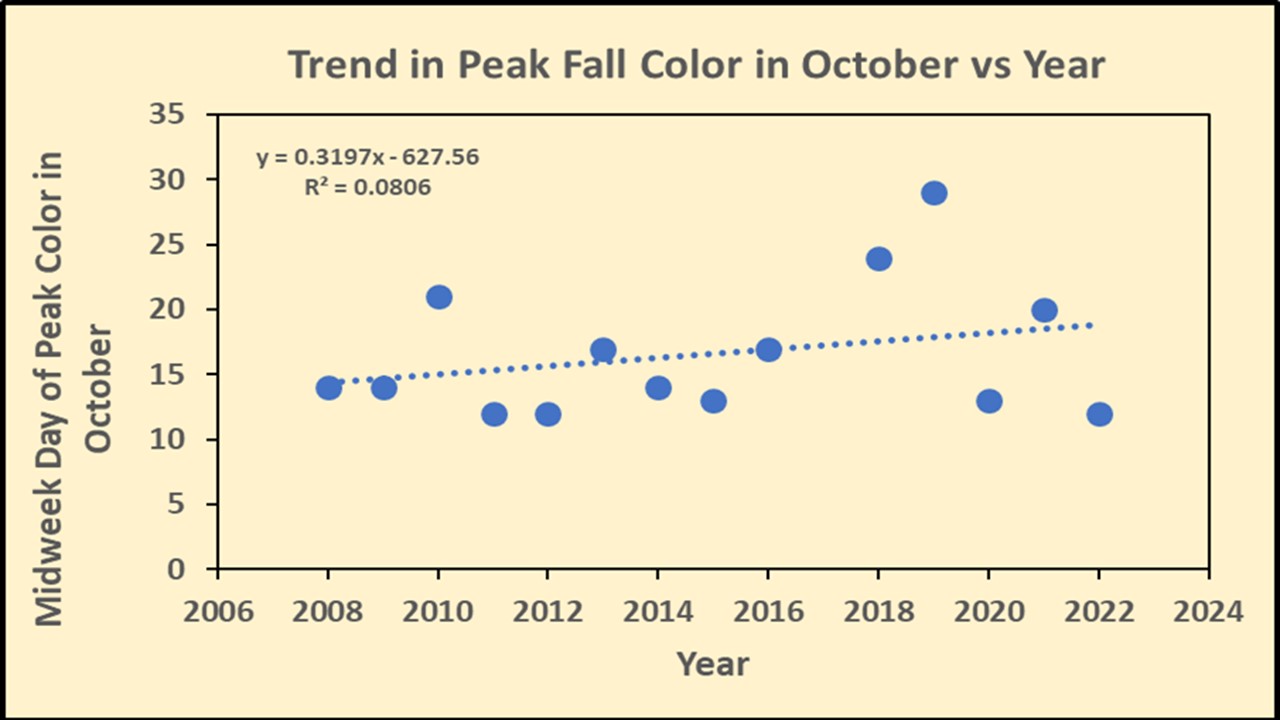
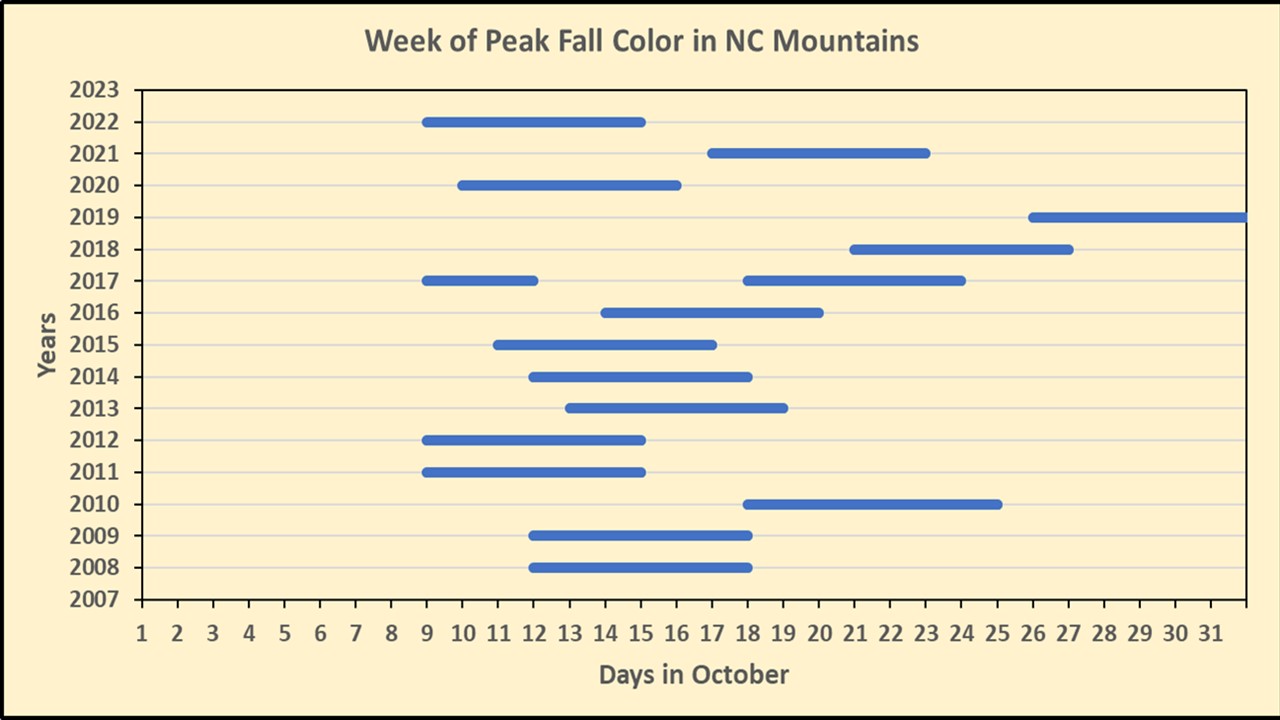
Fall Color Report for Week of August 20, 2023
It’s still quite early in the season to be making any definitive predictions about the fall colors we’ll get in a few months, but there are some signs to take note of. First off, we are not in a drought situation. We’ve had abundant rain this summer, the soils are quite moist, and the trees aren’t showing any signs of distress. Of course, that could change between now and the end of September, but so far so good.
Second, the long-range NOAA forecast (see attached figure) suggests that we will have slightly elevated temperatures through November and above normal precipitation. Both of these would lead me to predict that colors could be slightly delayed this year. The excessive rainfall, if it happens, could dampen the brightness of the red colors, especially if we get a lot of cloudy, rainy days in late September and early October.
As I noted in a previous posting, our urban maples are starting to turn color, as they always do at this time of year, as are the native flowering dogwoods. Buckeyes are also losing their leaves now, which is something they do early each fall. You may also be seeing a lot of browning along roadsides. That is most likely black locust, which is attacked in late summer by a native insect known as the locust leaf miner. This is an insect that eats out the inside of black locust leaves (it mines the leaf for food, so to speak, hence its name). The leaves then turn brown, die and fall off. It looks worse than it is, but this is a native predator and the trees seem to tolerate the damage, no worse for wear.
There are numerous native wildflowers and garden plants putting on a flowering show at this time of year, including evening primrose, jewelweed (both yellow and orange), goldenrod, ironweed, white aster, bee balm, yarrow, phlox, hydrangea, and Joe-Pye weed. You can also find the white Indian pipe in wooded areas. Most of the species mentioned are attached in the photos provided.
For those planning a trip up to the High Country, remember that colors will start first at higher elevations, and then move downward over time. In the Boone/Blowing Rock area, that means peak colors will be around mid-October (12-20th), unless warming delays the onset of coloration. But we won’t be able to pin it down better until we get closer to those dates.
Hope you have a good end to your summer and a fun Labor Day weekend. I’ll post again next weekend.





